Washington State Department of Enterprise Services (DES)
Capitol Campus
EAP | Capitol Campus
- Developmental Job Assignment
The state of Washington strives to attract, develop, and retain a talented and well-prepared workforce.
Providing employees opportunities to explore career interests through assignments that are uncommon in their daily work:
- Allow them to grow professionally.
- Allow the agency to pursue initiatives using resources that would not otherwise be available.
A developmental job assignment is a formal opportunity for an employee to develop professional knowledge, skills, and abilities that would not otherwise be available through their normal work activities.
Developmental job assignments should be primarily a product of the employee’s Performance and Development Plan (PDP). However, employees or the agency may pursue those assignments outside of this process.
Developmental job assignments are voluntary. Developmental job assignments will normally last no more than twelve months, and must have prior approval of the current Agency Head. Employees must have a six-month break between developmental job assignments. The time length and extensions of all assignments must include written justification.
Employees in developmental job assignments retain their own position number, draw their current salaries (including any scheduled periodic increments) and do not attain permanent status in any other classifications.
Funding is normally absorbed by the loaning (permanent) program unless prior arrangements are made to pay by the program with the developmental assignment. This includes travel and training. Developmental job assignments may be terminated by any of the parties with at least seven calendar days’ notice, unless a shorter notice period is mutually agreed upon.

Take Action
- The scope of the developmental job assignment should be clearly documented and approved by the supervising and hiring managers, the agency head and HR, before advertising the assignment.
- Learning goals should be established and documented before the employee begins the assignment.
- Developmental job assignments may be part-time or full-time.
- Employees are not expected to have all skills necessary to perform the tasks or project independently, but should have the aptitude, ability, and ambition to complete assignments with reasonable oversight.
- Since the primary purpose of a development job assignment is to support employee growth, assignments should be beyond current skill level. For example, a Fiscal Analysis with 10 years of experience in accounting would probably not be the best choice for a development assignment in entry level accounting. The assignment would not expand the employee’s skill set and would deprive a less experienced employee of the learning opportunity.
- The salary of an employee who accepts a developmental job assignment remains the same.
- There are no guarantees of future pay increase, promotion, or permanent job change.
- The developmental job assignment should not evolve into a permanent position without competitive recruitment.
- Employees are expected to go back to their previous position.
- Employees may not accept another developmental job assignment for at least six months after completing an assignment.
- At the end of the developmental job assignment, the supervisor and employee should complete a detailed evaluation of the learning experience, and place this documentation in the personnel file.
- Developmental job assignments are not transfers, and the employee is expected to return to their previous job. Therefore, the employee’s salary is typically paid by their home program. However, funding sources may be alternatively arranged through prior mutual agreement between programs.
- Developmental job assignments may be ended at any time by the employee or hiring manager (with approval by the appointing authority) with seven (7) days’ notice. Reasons to end a developmental job assignment early may include, but are not limited to: unexpected end of project; poor attendance or the unreliability of an employee; performance issues, etc.
Related Topics
- Developmental Job Assignment Agreement
- Access the Sole Source Contracts Database
- Buying Vehicles
- Contract Liaison Services
- Contract Usage Agreement for Public Benefit Nonprofits
- Current Commodity Pricing
- Customer Satisfaction
- Green Purchasing
- IT Professional Services Contracts
- Language Access Contracts
- Reporting Agency Contracts
- Reporting IT Contracts
- WEBS Enhancements for Supplier Diversity Policy
- Procurement Risk Assessment
- Technology Leasing
- Fleet Cards
- Amazon Business New Account Advanced Setup Guide
- Amazon Business New Account Simple Setup Guide
- Washington State Procurement Manual
- Register for Bid Opportunities
- State Contracts Assistance Network
- Tips for Small, Diverse and Veteran-Owned Businesses
- Bid Opportunities
- Bid in an Online Auction
- Surplus Digital Storefront
- Surplus Real Estate
- Federal Surplus
- Surplus for Eligible Organizations
- Register to use Surplus Property Disposal Request System
- What can my Organization Surplus?
- How to Surplus Items
- Transport & Storage
- Contact Surplus Operations
- Parents and Caregivers
- Frequently Asked Questions
- How do I become an EAP Network Provider?
- Information and Forms for Currently Contracted Providers
- Frequently Asked Questions for Providers
- Public Employers
- Brochures, Posters, and Guides
- Employee Newsletter
- Supervisor Newsletter
- Racism & Mental Health Resources
- Subscribe to Receive EAP News
- How EAP helps supervisors
- Incident Stress Management Tools
- Presentations
- Request an EAP organizational Consult
- Statewide Mediation Services
- Suicide Prevention and Intervention Resources
- Barrier Free Facilities
- Campus Color Initiative
- Capitol Campus Energy Meter Installation
- Capitol Childcare Center
- Distributed Antenna System
- East Plaza Water Infiltration Repair
- Irving R. Newhouse Building Replacement project
- Joel Pritchard Library project
- Legislative Modular Building
- LCM SEPA Checklist Supporting Documentation
- Old Capitol Flue Pipe and Fuel Storage Tank Replacement
- Plaza Garage Projects
- SEPA Environmental Review
- Sid Snyder Avenue Underground Utilities Project
- Sidewalk and ADA Access Improvements
- Photo Gallery
- Building Projects
- Childcare Options for State Employees
- Helen Sommers Building
- Accessibility Information for the Legislative (Capitol) Building
- Capitol Facts & History
- Visitor Accommodations
- Updating Emergency Notification Contact Method Settings - via the Everbridge App for Android
- Updating Emergency Notification Contact Method Settings - via the Everbridge portal
- Updating Your Emergency Notification Contact Method Settings - via the Everbridge App for iOS
- WA Agency Alerts Troubleshooting
- Capitol Campus Lost and Found
- Capitol Master Plan
- Featured Project Archive
- Getting to the Capitol
- Arc of Statehood
- Boiler Works
- Du Pen fountain
- George Bush monument
- Glass and Stone Mosaic Mural
- Helen Sommers Building Artwork
- Korean War memorial
- Law enforcement memorial
- Medal of Honor memorial
- Mysteries of Life
- POW-MIA memorial
- Senator Cal Anderson Memorial
- Territorial Sundial
- Tivoli fountain
- Untitled Stainless steel
- Vietnam Veterans memorial
- WW II Memorial Tile Search
- Water Garden
- Winged Victory monument
- Woman Dancing
- World War II memorial
- Open Carry of Weapons Prohibited in State Capitol Buildings and on West Campus Grounds
- Capitol Lake Trails
- Centennial Park
- Deschutes Parkway and Interpretive Center
- Heritage Park
- Marathon Park
- Pollinator Garden
- Sunken Garden
- Sylvester Park
- Campus Use Rates
- Schedule an Event
- Civic Education Tours
- Things to See on the Capitol Campus
- American White Elm
- Atlas Cedar
- Autumn Brilliance Amelanchier
- Big Leaf Maple
- Bush Butternut/White Walnut
- Centennial Challenge
- Cloud 9 Dogwood
- Crimson King Norway Maple
- Dawn Redwood
- Douglas Fir
- Eastern Flowering Dogwood
- English Oak
- Evergreen Magnolia/Southern Magnolia
- Giant Sequoia
- Japanese Cryptomeria
- Japanese Snowbell
- Kwanzan Flowering Cherry
- Northern Catalpa
- Norway Maple
- Purple-leaf European Beech
- Saucer Magnolia
- Serbian Spruce
- Sweetbay Magnolia
- Thornless Cockspur Hawthorn
- Tulip Tree/Yellow Poplar
- Washington Moon Trees
- Weeping Cutleaf Redleaf Japanese Maple Tree
- Western Hemlock
- Western Red Cedar
- Yoshino Flowering Cherry
- Young Weeping European White Birch Tree
- Visiting During Legislative Session
- Volunteer as a State Capitol Tour Guide
- Changes to the Small Works Roster
- EDGE Program
- Forms/Reference Documents
- Public Works Bidding
- Become a Selection Panel Member
- Bid Information
- Current Projects Advertised for Consultant Selection
- Frequently Asked Questions about B2GNow & Diversity Compliance
- Join the Architect/Engineer Reference File for Public Agencies
- How Consultants Are Selected
- Join the Architect/Engineer Reference File
- Trade Categories & Specialties
- Glossary/Definitions
- Policies/Processes
- How to Bid on Public Works Projects
- Job Order Contracting
- Small Works Roster
- Reporting Apprentice Hours
- Guidelines for Design-Bid-Build
- GC/CM Project Selections
- About Green Building & LEED
- Building Commissioning
- ESPC Success Stories
- Energy Efficiency Resources
- Energy Life Cycle Cost Analysis
- Energy Program Contacts
- Energy Project Management Services
- Energy Savings Performance Contracting
- Energy Service Company Partners
- December 2016 Report
- December 2015 Report
- December 2014 Report
- December 2013 Report
- Green Building & LEED
- Reports and Case Studies
- Request Our Services
- Building Access
- Custodial Services
- General Information
- Maintenance & Operations/Building Automation
- Project management, alterations and additions
- How Real Estate Services can help
- Important Laws that Apply to State Facilities
- Leasing Property to the State
- Market Searches
- Properties For Sale
- Real Estate Services - Contact Information
- Requests for Information
- Service Fees
- Solicitations for Leased Space
- Client Workshops
- Contact My Project Manager
- Instructions for Public Agencies
- Project Delivery Systems
- Project Information & Reference for School Districts
- Accident Reporting
- 2022 Rate Adjustment FAQ
- Driving a State Fleet Vehicle: How-To Videos
- Electric Vehicles
- Fleet Management Best Practices
- Fleet Operations Mileage Reporting
- Fleet Operations Roadside Assistance
- Fleet Services and Repairs
- Fueling State Vehicles
- Register for Fleet Rentals
- Report Lost or Stolen Plates & Fuel Cards
- Services for Agency-Owned Vehicles
- Traffic Citations
- Vehicle Utilization
- Visitors and the General Public
- Windshield Repair or Replacement
- ADA Accessible Parking
- Agency Vehicle/Reserved Parking
- Benefits for Carpool/Rideshare Parkers
- Bicycle Registration & Agreement
- Capitol Campus Employee Parking Fees
- Capitol Campus Parking Fees
- Employee Capitol Campus Parking Frequently Asked Questions
- Employee Parking (for personal vehicles)
- General Public - Visitor Parking
- Parking Strategy Implementation Plan
- Policies & Other Requirements
- Visitor Parking on the Capitol Campus
- Where Do I Place My Parking Permit?
- Capitol Campus Daily Rental Fleet
- Contact Fleet Operations
- DOH Daily Rental Fleet
- Daily Rental Fleet Locations
- Enterprise Rent-A-Car
- Fleet Operations HQ Daily Rental
- Reservation Frequently Asked Questions
- State Vehicle Frequently Asked Questions
- Travel Calculator
- Tumwater Daily Rental Fleet (Vans)
- Air Travel FAQ
- Lodging FAQ
- Passenger Vehicle Purchase Request
- Per Diem Information
- Transit Buses
- Vehicle Purchasing Frequently Asked Questions
- Vehicle Purchasing
- Contact Your Customer Service Representative
- Customer Support
- Directions to the Printing Facility
- Forms and Templates
- How to complete the A21-A Printing Request Form?
- How to complete the A24-A Copy Center Request Form?
- About Mail Services
- Consolidated Mail Services Distribution Map
- Contact Mail Services
- Electronic Return Receipt
- Getting Started
- Inserting & Mailing Preparation Services
- How to use the Mailing Instruction Form or "Pink Slip"
- Mail guidelines
- Postal regulation regarding window envelopes
- Sending and receiving mail
- State Document and Mailing Standards
- Map and Directions to Consolidated Mail Services
- News and Updates
- Binding and Finishing
- Copy Center
- Fulfillment
- Large Volume and Specialized Printing
- Mailing and Shipping
- Merge/Purge
- Posters, Mounting, and Laminating
- Prepress Services
- Printing Services
- Printing and Imaging Inserting Services
- Specialty Printing
- Standard Folds
- Variable Printing
- Print Job Consultation Procedure
- Change brings challenges, encouragement and collaboration to Printing and Imaging
- Online Ordering
- Printing and Imaging program helps customers find the highest quality for the best value
- With a little coaching, Printing and Imaging employees are defining clear goals
- Production Services
- Request an Estimate
- How to Become a DES Printing and Imaging Customer
- How to Become a DES Printing and Imaging Vendor
- How to Check a Proof
- How to Create PDF Files
- How to Design Your Mail Piece
- How to Perform a Press Check
- How to Preflight Your Job File
- How to Prepare Your Address Files
- How to Prepare and Submit Files for Variable-Data Printing
- How to Send Us Your Electronic Mail Address Files
- How to Submit Word or Publisher Files
- Imagesetting Tips
- Money Saving Tips
- Printing Standards
- Proofreading Marks
- Sample A21-A Printing Request Form
- State Printing Services Bidding Process and the Use of WEBS
- Sustainable Printing
- Use of Printing and Imaging
- Trainings & Consultation
- Contracts and Procurement Support
- Agency Assignments
- Agency Required Policies - Quick Reference Guide
- Chart of Accounts
- Common Budget and Fiscal Terms
- Finance Toolkit
- Frequently Used Travel Websites
- Internal Control For Cash Receipts
- TEMS Access Request Form
- Travel Do's & Don'ts - Quick Reference Guide
- Travel Policies & Related Issues - Quick Reference Guide
- Travel and Expense Management System - TEMS
- Appointment Letter Templates
- Deferring Excess Vacation Leave
- Determine Insurance Eligibility
- Employee Information Changes
- Employee Performance Management
- Equal Pay and Opportunities Act Guidance
- Family Medical Leave Act
- Harassment, Discrimination, or Retaliation Complaint Process
- Leave & Holidays
- Leaving State Service
- Mobile Work
- New Hire Forms
- No-Call, No-Show Process
- Paid Family & Medical Leave
- Reasonable Accommodation - Employee
- Rehire Forms
- Shared Leave
- Transfer Employee Forms
- Voluntary Employees' Beneficiary Association - Medical Expense Plan
- 2018 Archive HR News
- 2019 Archive HR News
- 2020 Archive HR News
- Policy Information
- State Employee Services
- Small Agency HR
- Small Agency Meetings
- Exempt Management Service
- HR Liaison Resources
- Infants at Work
- Investigations
- Non-Traditional Workers
- Onboarding a New Employee
- Paid Family & Medical Leave - Employer
- Personnel/Payroll Data Sheet Guidance
- Policy Development
- Position Action Form Guidance
- Reasonable Accommodation
- Recognition
- FrequentlyAskedQuestions
- Job Seeker Support
- Diversity Recruitment Resources
- Veterans Outreach
- Getting Ready to Recruit
- Online Recruiting System
- Planning Your Recruitment
- Preparing for Your Recruitment-Checklist
- Recruiting a Diverse Candidate Pool
- Retaining Your Employees
- Tools & Resources
- Recruitment
- Required Workplace Posters
- Separating Employment - Disability Separation
- Separating Employment
- Shared Leave Pools
- Washington General Service
- Washington Management Service
- Small Agency Support - One Washington
- Workshop Materials
- Required and Recommended Training
- Training & Development Staff
- Training Manager Meeting
- Browse by Category
- Browse by Course
- Business Analysis Certificate
- Graphic Designer | Certificate
- Leadership Certificate
- Project Management Certificates Program
- Technical Solutions Delivery Certificate (Systems Analyst)
- Crucial Learning Toolkits and eLearnings
- Contract & Procurement Training Search
- DES Diversity, Equity and Inclusion Training
- Leading Organizations
- HR Leadership Resources
- Franklin Covey All Access Passes and eLearnings
- External User Training Request Registration Form
- LinkedIn Learning Administrators Toolkit
- Online Learning Resources for Workforce Development
- Attendance Policy
- Learner Expectations
- Training Locations and Maps
- Vendor Resources
- Training Professional Accessibility Resources
- Brand Style Guide
- User Guides & Resources
- WA State eLearning Classes
- Overnight and extended parking on Deschutes Parkway
- Pedestrian Bridge Banner Policy
- Unmanned Aircraft Systems (UAS)
- About Risk Management
- Commercial Insurance Claim Reporting Procedure
- Commercial Insurance Policies
- Enterprise Risk Management
- Health & Welfare Programs
- Insurance for State Agencies
- Joint Property & Liability Programs
- Local Government Self-Insurance Program Links
- Local Government Self-Insurance
- Loss Prevention Review Team Reports
- Loss Prevention Review Team
- Loss Prevention Services and Training
- Loss Prevention Program
- Notary Bonds
- File a Tort Claim
- Pool Reports
- Regulatory Action
- Related RCWs
- Reporting an Accident Involving a State Driver
- Risk Finance Program
- Risk Management Contacts
- State Agency Self-Insurance Liability Program
- State Vehicles and Drivers
- Vendor Debarment
- A to Z Index
- Jobs at DES
- Capitol Lake
- Public Works Business Diversity Program
- Cross-laminated timber pilot project
- Lacey Encampments
- Success Stories
- Business Diversity Advisory Group
- Capitol Campus Design Advisory Committee
- Background and Reference
- 2014 CPARB Meeting Archives
- 2015 CPARB Meeting Archives
- 2016 CPARB Meeting Archives
- 2017 CPARB Meeting Archives
- 2018 CPARB Meeting Archives
- 2019 CPARB Meeting Archives
- 2020 CPARB Meeting Archives
- Member Information and Bios
- Public Works Data Collection Effort
- Board Development Committee
- Business Equity/Diverse Business Inclusion Committee
- Education Connections Committee
- General Contractor/Construction Manager Committee
- JOC Evaluation Committee
- Legislation Writing\Drafting Committee
- Local Government Public Works Study Committee
- Project Feedback Process Workgroup
- SHB 1621 Review Committee
- Small Works Committee
- Task Force & Committee Archives
- WSDOT Project Delivery Method Review Task Force
- Procurement Customer Advisory Group
- Supplier Diversity Community of Practice
- 2014 PRC Meeting Archives
- 2015 PRC Meeting Archives
- 2016 PRC Meeting Archives
- 2017 PRC Meeting Archives
- 2018 PRC Meeting Archives
- 2019 PRC Meeting Archives
- 2020 PRC Meeting Archives
- State Building Code Council
- State Capitol Committee
- Training Advisory Group
- WACS - Archived Meetings
- Pro-Equity Anti-Racism at DES
- How To's
- LGBTQ+ Organizations
- Training & Education
- Publications & Reports
- Media Contacts
- Program Contacts
- Locations and Directions
- Capitol Campus Interactive Map
- Public Record Request
- Privacy Notice
Free Templates and Tools for Trainers, HR professionals, Team Leaders, Facilitators and other enthusiasts

Developmental Assignment Template

Developing leaders by placing them on specific assignments is a great way to broaden their perspective while ensuring their highest development needs are being addressed in a structured way. The template (download link below) ensures transparency regarding developmental focus and management expectations of the outcomes of an assignment.
An assignment may require a change in location, but not always. An assignment could also be a temporary changed reporting relationship or being part of a different group or business unit. A different group of colleagues and managers to work with provides an assignee with the opportunity to broaden his or her internal network and learn to build relationships fast. International assignments can add additional learning objectives such as developing more cultural awareness and skills involving collaboration and communicating across cultures.
The example shown, helps to illustrate how one would go about using the developmental assignment template I am sharing above (see download link).
What should he/she learn?

The areas to develop (called Leadership Aspects in the example) would depend on the competencies that have been selected for leadership development and the latest ratings from the performance management process can be used to provide you with the ratings for each leader. This helps you to focus on the development needs with the highest priorities at that time. A conversation with the leader’s direct manager could be very useful in selecting the highest priorities. If the employee had been included in a recent talent review, there may be additional information available to complete the template and select the focus areas for his or her leadership development.
How will he/she learn?

Selecting the development activities, it is important to first understand specifically which aspect of that development priority the employee needs to learn more about.
- Theoretical (mainly improving awareness)? Then an online self-paced course could be the answer. Or even sending the employee to attend an external class or read a book (or selection of books).
- Learning new behaviors? Coaching and feedback based on actual examples encountered could be a good approach. You could also do a pre-test and post-test with some experiential workshop or learning intervention taking place between the tests. Workshops which include options to practice new behaviors can be great solutions.
A combination of learning interventions is the best way to address development needs. Look at each high priority learning need and look for ways to combine class-room training, self-paced learning, short On The Job (OTJ) assignments or tasks and perhaps coaching too. Each of the interventions would then strengthen learning and reinforce principles introduced.
Be sure to document who will mentor or coach the employee. He or she needs to understand the support you are making available to him/her on the journey of learning new skills.
What is the definition of Done?

Spend some time considering how you will close out the assignment with the specific learning needs. Will you want a written report detailing the learning that took place over the assignment period? Or will you want a report and also a presentation? Or perhaps just assign a presentation to be developed whereby the assignee is asked to share his or her key learning achievements with a panel of senior-level stakeholders? Assign the completion activity early so the assignee can prepare for it from the moment he or she starts the new assignment.
Include stakeholders early
Share rating templates with the intended evaluation panel and the assignee before the final event or evaluation of a written report. The transparency helps all concerned to anticipate the level of detail required and where the focus areas will be. This helps the employee prepare from early-on in the assignment to provide the required final product or presentation.
Documenting the learning objectives of an assignment helps to orient and align all stakeholders on how to positively impact the development of that leader – the leader himself/herself, his/her direct manager or supervisor, his/her coach and HR or L&D staff supporting the assignment.
Share this:
Published by jo-anngarbutt
My mind is insatiably curious and I have read and collected several good articles, advice, tools, templates, and lessons along the way. These have helped me at work, with projects, and at home. This is my attempt to share some of that back to others trying to learn more and with the world. View all posts by jo-anngarbutt
Leave a comment Cancel reply
This site uses Akismet to reduce spam. Learn how your comment data is processed .

- Already have a WordPress.com account? Log in now.
- Subscribe Subscribed
- Copy shortlink
- Report this content
- View post in Reader
- Manage subscriptions
- Collapse this bar
FederalCareerInfo.com
FedCareerInfo. com
- Introduction
- Upward Mobility
- Keys to Success
- Federal Training Laws
- Career Planning Checklist
- Privacy Policy
- What to Expect
- Getting Started
- Assessing Skills, Experience, Interests
- Assessment Worksheets
- KSA Samples
- KSA Checklist
- Additional Resources
- Occupational Families
- Wage Grade Occupations
- Qualification Standards
- Merit Promotion Program
- Career Development Charts
- Preparing Your Plan
- Career Development Checklist
- Goals & Objectives
- Preparing Your IDP
- Developmental Assignments
- Tony’s Story
- Infomational Interview Process
- Before the Interview
- During the Interview
- Closing Phase
- Illegal Questions
- After the Interview
- Sample Thank You Letter
- Who Gets Hired
- Required Information
- Eligibility Determination
- Resume Assistance
- Apply for Jobs
- Improve Your Chances
- Merit Promotion MPP
- Internal Placement IPP
- Voluntary Applications
- Hardship Transfers
- Details and Temp Promotions
- Job Announcements
- Job Listings
- Federal Resumes
Supervisory Developmental Assignments
Work assignment practices, federal employee's career development center.
The following activities are available for developing your supervisory knowledge, skills, and abilities at little or no cost to the agency. This list is not all-inclusive and should, at a minimum, stimulate other ideas for developmental assignments.
Supervisory Development Assignments Menu
Shadowing assignments, professional reading, job rotation, developmental staff meetings.
- Professional Organizations
Volunteer Work
- Complete Your IDP
The employee’s supervisor:
- Identifies and assigns specific work projects which relate to IDP development objectives and activities;
- Discusses with the employee how the project’s content or process ties in with the IDP;
- Communicates any specific standards or expectations for project results and developmental aspects;
- Solicits the employee’s self-assessment at completion of the project; and
- Provides feedback.
This process requires creativity and an eye for opportunity on the part of the supervisor, who must be able to identify a stretch activity with good probability for successful accomplishment. In many cases, development objectives may represent skill areas where employees need more than one activity to practice, achieve, and reinforce the desired ability. For example, the ability to negotiate and persuade others to accept a given course of action may be practiced with increasingly complex issues or with clients or peer groups who are progressively more difficult to convince.
The supervisor needs to be alert to developmental opportunities which may not be obvious to the employee. For example, a routine coordination project complicated by unusual pressures, difficult personalities, limited resources, or which is under another supervisor’s jurisdiction, offers numerous opportunities to apply persuasive skills.
A shadow assignment involves a temporary assignment to a supervisor or manager to learn through observation how to more successfully accomplish tasks and/or projects. It also provides an opportunity to observe different supervisory styles and to observe the scope and nature of target positions.
Assignments can be as short or as long as necessary to acquire the needed learning. They can range from a few hours to observe methods or processes, to several weeks in order to become familiar with functional and interpersonal relationships or to observe the effective management of programs and human resources. Employees particularly benefit from assignments timed to coincide with key staff meetings, labor-management consultations, strategizing on budget and staffing, etc.
It is sometimes helpful to prepare the employee for the assignment through background reading or orientations covering key projects or problems that will be encountered. This will help the employee concentrate on current interactions and decisions during the assignment, rather than on past history. Assignments are enhanced when the supervisors/managers being shadowed candidly discuss the rationale of their decisions and actions, answer probing questions from the employee, comment on alternatives, and share what they have learned from past decisions which had unsuccessful results. As the employee progresses from observation to a greater degree of give and take, there is a better opportunity to increase knowledge and to double-check assumptions.
The employee plans and carries out a systematic program of reading periodicals and books. The employee is encouraged to seek out specific opportunities in the work place to apply the theories studied, and to discuss these potential applications with his/her supervisor. This discussion should benefit both the employee and the supervisor and increase the likelihood that the theories studied will be appropriately examined and applied in light of operational realities.
Job rotation involves interchanging (reassigning) employees from one job to another for developmental purposes. Assignments may be short or long-termed actions involving moves between positions of a different nature. Examples of these moves include between line and staff positions and headquarters and field positions. Job rotation differs from details in that assignments, while they are understood to be impermanent, are nevertheless indefinite. Employees must therefore meet qualifications requirements for the positions to which reassigned. Job rotation affords many advantages to both the employee and the agency:
- Provides well-rounded training and a variety of experiences for the employee. It familiarizes the employee with many facets of agency operations and prepares the employee to make more knowledgeable decisions.
- Streamlines the work unit through periodic introduction of new viewpoints by eliminating unnecessary practices or operations which may have been carried over for a period of years.
- Stimulates development of the employee through the element of competition.
The supervisor uses recurring staff meetings as vehicles for developing the knowledge, skills, and abilities of employees; i.e., leadership, group processing, problem resolution, coordination, conflict resolution, decision making, oral communications, briefing and presentation skills, listening and questioning techniques, constructive but critical review and feedback, time management, and meeting management.
Techniques which may be used include (1) rotating assignments for preparation and conduct of the meeting among employees; (2) having the rotating leaders review meeting objectives and identify effective procedures for achieving the stated objective (such as group interaction); and (3) using peer feedback to assess whether or not the objectives were met and to what extent. Topics can range from routine status reviews to projection of new programs or specific problem resolutions (for example, a discussion on ways to improve in-house communications).
This activity is easily integrated into daily work as an alternative to the more common staff meeting led by the supervisor. It increases participation and involvement by employees and gives the supervisor an additional opportunity to observe the relative strengths and weaknesses of his/her employees. Other in-house supervisors can serve as resources in identifying useful techniques in problem identification and resolution, and employees can volunteer for meetings which match IDP objectives.
The relatively small and familiar staff can serve as a supportive group, and the “good stress” of friendly competition can lead employees to higher performance levels and accomplishments. An additional benefit of developmental staff meetings is that they enhance team building since employees have the opportunity to learn more about the expertise of their peers and are exposed to the value of cooperation within the work unit.
Participation In Professional Organizations
The employee is encouraged to identify those development needs which might be enhanced by participating in the activities of a professional organization. These organizations afford an opportunity for the exchange of practical information with colleagues in and outside the government. Interaction with others sharing occupational and/or avocation interests can contribute to state-of-the-art knowledge and professional growth. Participation must extend beyond merely reading the organization’s journals and must provide experience which enhances interpersonal and supervisory skills.
The employee is encouraged to identify those development needs which could be enhanced through volunteer functions with organizations or employee participation groups. Volunteer organizations or groups pose a special challenge to the employee. The employee must influence the behavior of others that are not under his control. The employee benefits from active involvement in the management and operation of the group. Participation must include more than attending meetings and/or paying dues. Prior to becoming a manager, I volunteered to manage my son’s little league team and spent two years on the board as Vice President.
Networking is maintaining channels of communication among and between specific groups or individuals. As a developmental device, the purpose is to en-courage the employee to initiate personal contacts and maintain open channels of communication throughout the organization, as well as with other groups from which the employee can also benefit. As an example, within the Supervisory IDP pool, participants could network among themselves. The result is often an improved individual awareness of the work organization’s dynamics and an avenue for obtaining needed information from other related organizations.
Several different strategies can be used to facilitate network building, including participation in professional organizations, committees, and volunteer groups. Network building is especially useful for employees who have few contacts outside their own part of the organization.
Network building takes time and may not show an immediate, obvious payoff. However, there is substantial long-term potential for improved communications and cooperation within the agency, as well as for better-informed employees.
Next Step: Complete Your IDP
Growing Skills with Development Assignments
Last Updated on October 24, 2021 – 6:40 pm
Every modern company prefers to attract employees with the proper skills and experience to work for them. However, hiring managers often face a different reality: searching for this kind of employee is like scouring the haystack for a tiny needle. As companies increase their spend toward employee development and training, they also go beyond a few traditional learning opportunities to create effective employee development programs. Training and Development Assignments are one way by which they can achieve this.
Employee development focuses on collaborating with employees to enable them to acquire, develop, improve, and hone existing skills. It aims to build a talent pool to bolster the company’s mission while creating highly engaged employees.
Skills themselves refer to the mix of abilities, experiences, and qualities one may use to get stuff done. Skills may include interpersonal, leadership, and organization skills – so-called soft skills . Other skills such as accounting, application development, research, and writing are technical skills.
Deliberately improving skills can help employees achieve personal career goals, including earning a promotion or becoming more proficient in specific areas. An employee’s skill set may be necessary to advance in one career or pivot to another. Let’s now turn our attention to how employees can grow skills through development assignments.
Defining Development Assignments
Development or developmental assignments allow employees to take on tasks outside the purview of their primary work assignments. However, their tasks remain well within their functional area.
The idea behind developmental assignments is to grow a workforce adequately qualified to perform current and future career functions with equal skill. Leaders advance more through challenging assignments than by exercising routine competency.
There are plenty of opportunities that emerge when participants take on novel tasks of significant complexity. These developmental tasks can include any of the following:
- unfamiliar responsibilities,
- establishing a new program, and
- developing solutions to complex multi-factor problems.
Interestingly, developmental assignments may not count much towards a promotion. But, they are critical in increasing skills, knowledge, and experience, which ultimately play a big role in career advancement.
Who Benefits Most from Developmental Assignment Programs?
While the employee seems to be the obvious beneficiary of developmental tasks, the employer stands to gain a lot down the road.
The new skills and experiences that employees garner in seeing out the stretch assignments primarily benefit the employer. These tasks typically last between 3 to 6 months before the employee returns to their primary assignment. During this time, the employee will be stepping outside their comfort zone but on mutually beneficial terms with the company.
As the worker grows professionally, the company can pursue projects using resources that would otherwise not be available.
Developing Developmental Job Assignments
Developmental job assignments should primarily proceed from an employee’s Performance and Development Plan (PDP). However, it should not stop them or the organization from seeking assignments external to this.
It’s important for developmental assignments to be flexible but within a readily identifiable framework of guidelines:
- Clear documentation and approval of the developmental job assignment by hiring and supervising managers and other stakeholders before advertising the assignment.
- Establishment and documentation of learning goals before the employee commences the assignment.
- The form of the developmental assignment may be full-time or part-time.
- The employee doesn’t need to possess all the necessary skills to perform the tasks or project independently. Nevertheless, they need to have an unmistakable aptitude, ability, and copious ambition to conclude the assignment with ample oversight.
- Assignments need to transcend the employee’s current skill level while supporting their growth and career development . There needs to be a healthy tension between entry-level training and development and the development task in question, for instance.
- The salary of an employee assuming a development assignment remains the same.
- Clear communication that there are no guarantees of future pay increase, promotion, or job change due to this assignment.
- The developmental task may not evolve into a permanent position without competitive recruitment.
- Employees should return to their previous position after the assignment.
- Employees need to wait a specified period (usually six months) before accepting another developmental assignment.
- The line manager and employee should complete a detailed evaluation of the learning experience upon the conclusion of the developmental assignment. This evaluation should go into the employee’s personnel file.
- Development assignments are not official transfers.
- There have to be mutually agreeable reasons for ending a developmental assignment earlier than planned.
A developmental assignment task may end early for various reasons, including an unexpected end to the project, poor attendance, performance issues, or an unreliable employee.
Organizations need to carry the mindset that assignments are development opportunities. They must first understand that they can optimize the ROI from development assignments. It’s feasible if their operating principles include understanding the value proposition of development assignments, establishing effective career path strategies, and understanding the proper use of global mobility.
Employees and employers need to be keen on developmental opportunities if they will both be relevant in an increasingly dynamic age.
If you want to learn more about employee development, you can check out our blog posts here .
Share This Story, Choose Your Platform!
About the author: andrea pejoska.
Related Posts

How a Successful Onboarding & Offboarding should be?

How to Enable Learning by Doing at Your Company

12 Statistics that Prove the Value of Employee Development

How to Set and Measure Employee Development Goals

The Great Resignation: What is the Role of Employee Experience?
Leave a comment cancel reply.
Save my name, email, and website in this browser for the next time I comment.
Employee Development
See Journey in Action
Job Application
Solution Partnership
Privacy Policy
Terms of Service
© Copyright 2024 | Journey App Inc.
Leadership Stories
- Non-Supervisors

Growing Leaders for the Public Service

Public Leadership Toolkit
How Leaders Learn to Lead
A Leadership Development Action Plan
Self-Awareness
Resilience
Personal Effectiveness
Coach
Delegate
Give Feedback
Motivate
Manage Meetings
Hire (and Fire)
Make Decisions
Onboard New Employees

Articles & Books on Public Leadership
Read about:.
Leading in Government
Leadership Philosophies
Character
Data-Driven Performance
Followership
Innovation
Leading Change
Engage Your Team:
Motivation Overview
Extrinsic Motivation
Intrinsic Motivation

Success Stories
Cautionary Tales
Biographies
Novels
Movies with Leadership Insights
Tell Stories as a Leader

Leadership Training
Executive Development Programs
Online Programs
Leadership Programs for:
U.S. Federal Government Agencies
U.S. State Governments
Australia, Canada, and the United Kingdom

Leadership Quotes
Gen. Bill Creech
Ben Franklin
Gandhi
Abraham Lincoln
Nelson Mandela
Colin Powell
Teddy Roosevelt
Quotes About:
Definitions of Leadership
Developing People
Initiative/Self-Empowerment
Persistence
Public Service
Taking Risks
All Quotes
Making the Most of Developmental Assignments
Q&A with Author Cynthia McCauley
By Don Jacobson
In her book Developmental Assignments: Creating Learning Experiences without Changing Jobs , Cynthia McCauley provides a superb framework to help leaders and aspiring leaders think clearly about how to use work assignments to develop leadership skills. McCauley, who teaches leadership at the Center for Creative Leadership recently discussed her book in a Q&A with GovLeaders.org.
Examples of Challenging Assignments
related articles.
- 22 Ways to Develop Leadership in Staff Managers
- Learning to Ride a Bike--and to Lead
- Using IDPs to Leverage Strengths
Related Books
- Developmental Assignments: Creating Learning Experiences without Changing Jobs , by Cynthia McCauley
- A Legacy of 21st Century Leadership , by James Trinka and Les Wallace
Search
Home • Disclaimer
Back to Top • Contact • Subscribe
- Organizational Structure & Leadership Team
- Activities & Responsibilities
- Contact Information - HR Teams
- HR Staff Directory
- Jobs at OSU
- Benefits Overview
- Benefits Calculator
- Prospective Employee
- New Employees
- Current Employees
- Student Employee
- Supervisors & Managers
- Appointment Renewal and Non-Renewal Model Letters
- Classification & Compensation
- Employee and Labor Relations
- Learning and Development
- Leave Management
- Mental Health Resources
- Onboarding Process
- Performance Management
- Policies and Contracts
- Position Descriptions
- Professors of Teaching
- Recruitment and Selection Resources
- Safety in the Workplace
- Academic Faculty
- Professional Faculty
- Classified Employees
- Graduate Assistants
- Sworn Officers
- Postdoctoral Scholars
- Student Employees
- Postdoctoral Fellows
- HR Professionals
- OSU Training Portal
- LinkedIn Learning
- FourSight Mindset Reveal
- Crucial Conversations for Mastering Dialogue
- FYI Friday Program
- Social Justice Education Initiative
- Search Advocate Program
- Core Curriculum for Managers & Supervisors
- Coaching Resources
- OSU Critical Training Program
Developmental Opportunity Appointment: Guidelines and Agreements
General information, appointment status during a developmental opportunity.
- Departmental Procedure for Initiating a Developmental Opportunity Appointment
- Classified to Unclassified
- Classified to Classified
- Unclassified to Unclassified
A developmental opportunity appointment is a temporary job assignment provided to a classified or unclassified employee. It provides the employee an opportunity to gain new skills and experience relevant to his/her career goals.
A developmental opportunity agreement is also required when a current classified employee is appointed to a short-term unclassified position when there is the expectation that he/she will return to the classified position.
A developmental opportunity appointment provides a current classified or unclassified employee with an opportunity to gain new skills and experience relevant to his/her career goals. The appointee generally does not receive a salary increase while serving in this temporary job assignment. The benefit to the employee during a developmental opportunity appointment is gaining increased skills and experience which will benefit their career advancement. Should there be a unique or unusual situation which may justify a salary increase, exceptions must be requested and approved by the Classification and Compensation Manager.
During the duration of the developmental opportunity appointment, the employee may be placed in a separate position with a different appointment type as outlined in the chart below. At the end of the developmental opportunity, the employee will be returned to his/her regular position. The chart below provides a general outline of the terms and conditions provided to the employee in the various appointment types used for a developmental opportunity.
Note: The chart below assumes the developmental opportunity is 1.0 FTE.
Department Procedure for Initiating a Developmental Opportunity Appointment
Please follow the steps below to initiate and fill a developmental opportunity appointment.
- Review and Approval of the Job Duties: The job duties for the developmental opportunity appointment must be reviewed by the BC-HRC2 in order to determine whether the position is classified or unclassified.
- Position description
- Position announcement
- Instructions on how to “apply” for the opportunity. Required applicant material, at a minimum, should include a letter of interest and a current resume. Include the name and contact information of the hiring supervisor. Direct applicants to contact the hiring supervisor with questions regarding the opportunity.
- Sample Developmental Opportunity Appointment Agreement Summary.
- How and where the opportunity was announced/advertised to potential applicants;
- A copy of the developmental opportunity announcement (see sample below);
- The length of the recruitment period;
- The name of each candidate who expressed an interest in applying for the developmental opportunity, and their current department(s);
- The specific job-related reasons for selecting the employee identified to work in the developmental opportunity; and
- The specific job-related reasons for not selecting the other employees that applied for the developmental opportunity.
Sample Announcement
I am pleased to announce a developmental opportunity that is open to all employees. This is an ( unclassified/classified) work assignment with a job title of (title or job classification) . Major duties and responsibilities assigned to this developmental opportunity are outlined in the document attached to this announcement (attach a summary page describing the job duties; please be specific). The appointment dates are anticipated to be (beginning date) through ending date). The appointee’s salary will not change from his/her current full-time annual salary rate. The benefit to interested applicants is the opportunity to gain new skills and experience relevant to their career goals. Application packets can be obtained from (name of contact) in the (college/ department/unit name ). The closing date for submitting applications is (date) .
- Complete the Developmental Opportunity Agreement: Upon completion of the search process and selection of the finalist, the Business Center will complete the attached Developmental Opportunity Agreement, according to the appointment type. When completing the agreement, please insert or select the appropriate name or term in those areas that are bolded and in italics. Obtain required signatures on the last page of the agreement. Submit the signed agreement to the classification and compensation manager. The classification and compensation manager will review and approve the agreement and return it to the hiring supervisor.
Classified to Classified Developmental Opportunity:
Department completes an Establish PD action if the selected employee is not filling an existing position, or Update PD action if the position already exists. The employee’s current classified position title must be selected for the position title. Do not initiate an Establish and Fill or an Update and Fill action.
The department must then upload a copy of the approved Developmental Opportunity Agreement to the Documents page of the action in the Online PD and Recruiting System.
Classified to Unclassified Developmental Opportunity:
Department completes an Establish PD action and selects the Academic Wage position title for the position. The employee cannot be placed in a regular unclassified position during the duration of this appointment. Do not initiate an Establish and Fill or an Update and Fill action. The department must then upload a copy of the approved Developmental Opportunity Agreement to the Documents page of the action in the Online PD and Recruiting System.
Unclassified to Unclassified Developmental Opportunity:
The department then completes the OSCAR developmental opportunity hiring task to place the employee’s existing job on leave and begin the new development opportunity job. The department must attach the approved Developmental Opportunity Agreement to the Job Form when submitting the task to OHR for processing in Banner.
Developmental Assessments
Discover the power of Developmental Assessment in understanding a child's growth. It helps identify developmental delays and enables interventions.

By Olivia Sayson on Apr 08, 2024.
Fact Checked by Ericka Pingol.

What is a Developmental Assessment?
A developmental assessment is like a compass for a child's journey of growth and development, serving as a guiding light to help them navigate the complexities of early life. It is akin to a map, uncovering the unique terrain of a child's abilities and potential, illuminating the pathways to support their progress.
A developmental assessment is a structured process that professionals, such as psychologists, speech-language pathologists, or occupational therapists, use to gain a comprehensive understanding of a child's development. Through interviews, observations, and standardized tests, the assessment aims to evaluate various key areas that contribute to a child's overall growth.
are powerful tools, like the treasures uncovered through exploration. They can identify developmental delays or disorders, helping parents and caregivers recognize areas where their child may need extra support or intervention.
Moreover, these assessments give parents valuable information about their child's strengths and growth areas. Armed with this knowledge, parents can support their child's learning journey and provide the right resources and encouragement.
Printable Developmental Assessment
Download this Developmental Assessment to effectively evaluate a child’s development.
How does it work?
The Developmental Assessment Template is a comprehensive and valuable resource that is crucial in facilitating a child's growth and development journey. Here's a step-by-step guide on how to make the most of this assessment:
Step 1: Obtain Printable Developmental Assessment Templates
To get printable developmental assessments, consult a qualified professional, such as a pediatrician, child psychologist, or educational specialist. They can recommend or provide appropriate assessment materials tailored to your child's age and developmental stage.
Step 2: Prepare a Comfortable Assessment Environment
Before starting the assessment, ensure a comfortable and distraction-free environment for the child. Creating a relaxed atmosphere is essential to encourage their best performance during the evaluation.
Step 3: Utilize a Variety of Assessment Tools
The developmental assessment typically involves a combination of tools and methods. These may include questionnaires, checklists, standardized tests, and child behavior observation in various settings.
Step 4: Conduct Parent or Caregiver Interview
The professional administering the assessment will often start with an interview or discussion with the parents or caregivers. They will ask questions about the child's milestones, strengths, challenges, and any concerns related to their development.
Step 5: Observe the Child's Behavior and Interactions
Next, the professional will observe the child's behavior, play, and interactions with others to gain insights into their social, emotional, and cognitive development. This observation may take place in a clinical setting, school, or home environment.
Step 6: Analyze Results and Provide Recommendations
Based on the assessment results, the professional will analyze the child's development in various areas, such as physical, language, cognitive, and social-emotional skills. If any developmental delays or concerns are identified, the professional will provide appropriate recommendations for intervention and support to help the child reach their full potential.
Developmental Assessments Example (sample)
The Developmental Assessments PDF is a comprehensive tool enabling professionals to deeply understand a child's development. It covers essential aspects such as the child's background, strengths, and areas for growth, offering a holistic view of their current situation and potential.
This assessment PDF incorporates critical developmental milestones based on recognized guidelines and standards. Professionals can evaluate a child's progress in key areas such as physical development, language skills, cognitive abilities, and social-emotional competence. By using this assessment, practitioners can identify areas where a child may need additional support or intervention to reach their full potential.
The template allows professionals to create personalized action plans tailored to each child’s needs. The assessment outcomes serve as a roadmap for designing intervention strategies that address specific developmental challenges effectively. By incorporating additional notes and observations, professionals can continuously monitor the child's progress and make necessary adjustments to the intervention plan over time.
The Developmental Assessment PDF is a powerful tool to support a child's growth journey. It empowers professionals with valuable insights, helping them nurture the child's development and ensure a brighter and more promising future.
Download this Developmental Assessment Example:

When would you use this Template?
The Developmental Assessment Template would be used to comprehensively evaluate a child's growth and development. It is typically employed by qualified professionals, such as pediatricians, child psychologists, speech-language pathologists, occupational therapists, or educators, to gain valuable insights into a child's physical, cognitive, language, and social-emotional development. Here are some specific scenarios in which it would be utilized:
Early Childhood Development
The template is commonly used during routine well-child checkups and developmental screenings for infants and young children. It helps identify any developmental delays or areas where a child may need additional support or intervention.
Educational Settings
Teachers and educators may use the template to assess students' progress in various developmental domains. This evaluation can inform instructional strategies and provide insights into students' strengths and challenges.
Special Education Services
The template is valuable in assessing children with suspected or diagnosed developmental delays or disabilities. It aids in creating Individualized Education Programs (IEPs) that outline specific goals and intervention plans.
Parental Concerns
When parents or caregivers express concerns about their child's development, the template can be employed to conduct a thorough assessment and address any areas of concern.
Research and Studies
The template can be used in research studies to collect standardized data on child development, contributing to the understanding of developmental milestones and norms.
Intervention Planning
The assessment outcomes form the basis for designing targeted intervention plans to support children with developmental challenges, ensuring they receive appropriate resources and support.
A Free Developmental Assessment Template offers numerous benefits to professionals, parents, and caregivers involved in assessing a child's growth and development:
Comprehensive Evaluation
The template provides a structured and comprehensive approach to assessing a child's development. It covers essential domains such as physical, cognitive, language, and social-emotional skills, ensuring a thorough evaluation.
Early Detection of Developmental Delays
The template aids in identifying developmental delays or potential challenges early on. Early detection allows for timely interventions and support, increasing the likelihood of positive outcomes.
Tailored Intervention Planning
Assessment outcomes guide professionals in creating personalized intervention plans based on a child's specific needs and strengths. These tailored plans maximize the effectiveness of support and resources provided to the child.
Objective Insights
The template provides a structured framework for data collection, reducing biases and subjectivity in the assessment process. This promotes objectivity and ensures that assessment results accurately reflect the child's abilities and challenges.
Communication and Collaboration
The template fosters effective communication and collaboration among professionals, parents, and caregivers. It is a common language to discuss the child's development and facilitates sharing insights and observations.
Research and Data Collection
The template can be used in research studies and data collection efforts, contributing to understanding child development and informing evidence-based practices.
Why use Carepatron as your Developmental Assessment app?
Attention professionals conducting developmental assessments! If you're in need of a user-friendly and efficient solution, look no further than Carepatron's Developmental Assessment Software and App. Whether you work independently or as part of a team, Carepatron offers the perfect platform to streamline your assessment processes.
Our app is designed to simplify administrative tasks related to developmental assessments. From easy appointment scheduling to secure client data management, we've got you covered. With an intuitive interface, you can quickly adapt to the software and focus on conducting comprehensive and accurate assessments.
Create professional reports effortlessly, impressing both clients and colleagues with Carepatron's advanced tools. Experience the efficiency and convenience of our Developmental Assessment App today, because the children and families you work with deserve the best possible care and support!
Join Carepatron now and elevate your developmental assessments to a whole new level of excellence!

Bayley Scales of Infant and Toddler Development, 4th Edition. Bayley, N. (2019). San Antonio, TX: Pearson.
Denver Developmental Screening Test, 5th Edition. Frankenburg, W.K., Dodds, J.B., Archer, P., Shapiro, H.S., & Breslau, N. (2018). Denver, CO: Denver Developmental Materials.
Ages & Stages Questionnaires, 3rd Edition. Squires, J., Bricker, D., & Twombly, E. (2017). Baltimore, MD: Paul H. Brookes Publishing.
Commonly asked questions
The Developmental Assessment is used by parents, doctors, early intervention providers, and researchers. Parents gain insights into their child's development while doctors diagnose delays or disorders and create treatment plans. Early intervention providers use assessments to design appropriate interventions, and researchers study children's development and influential factors.
The Developmental Assessment is commonly employed in early childhood to identify delays and provide early intervention for improved outcomes. School-age children may also undergo assessments to address academic or social-emotional difficulties. In certain cases, developmental assessments can be utilized in adulthood, particularly for individuals with neurological conditions affecting their development.
The Developmental Assessment is typically conducted by trained professionals, including psychologists, speech-language pathologists, or occupational therapists. The process involves interviewing parents or caregivers to understand the child's development, observing the child's interactions and play, and administering standardized tests to measure specific skills. The results of the assessment help determine typical development or identify delays and disorders, leading to the creation of tailored intervention plans.
Related Templates
SOAP Notes For Physical Therapy Template
An intuitive SOAP note template for physical therapists will help your practice improve its documentation, all while saving valuable time.
Autism Spectrum Test
Looking to assess autism spectrum disorders? Discover the best tools and strategies for healthcare practitioners in our comprehensive guide. Read now!
Apgar Score Chart
Use this Apgar Score Chart template to assess a newborn infant. Click here to download a copy and read a guide on how to score, interpret, and more.
SOAP Notes For Occupational Therapy Template
A simple, downloadable PDF template for taking SOAP Notes in occupational therapy.
Learn about drug tests and their importance, and get a comprehensive example questionnaire. Free PDF download available. Understand the world of drug testing.
Electromyography
Discover the power of Electromyography (EMG) tests! Explore their many uses and learn how to interpret results with confidence.
GMFCS Scale
Understand the Gross Motor Function Classification System (GMFCS) scale and its five levels of functioning. Learn how to use it with a free PDF template.
100 Therapy Questions
Here’s a list of 100 Therapy Questions you can ask your clients to know more about them or initiate a conversation during therapy sessions.
Social Skills Worksheet
Identify your patient's social skills strengths and weaknesses with this Social Skills Worksheet. Download a free PDF and example to get started.
Therapy Group Worksheets
Check out our therapy group worksheets to incorporate within your group therapy sessions. Designed to adapt to various therapeutic purposes, you can ensure higher engagement and more meaningful connections between participants.
Dissociative Experiences Scale
The Dissociative Experiences Scale is a clinical screening tool that assesses dissociation in patients. Download this PDF to evaluate dissociative tendencies.
Self Care Worksheets
Once your client has identified areas of their self-care they want to improve, it’s time to put together a solid plan. This Self-Care Worksheet will help determine objectives in their physical, personal, spiritual, psychological, and professional domains.
Popular Templates
Action Planning Worksheet
Maximize project success with our Action Planning Worksheet. Track and measure progress effectively. Download free templates for complete project management.
Cross Addiction Worksheet
Carepatron offers integrated software for therapy practice management, streamlining scheduling, billing, and clinical documentation for healthcare providers.
IADLS Assessment
Download our free IADLS Assessment template to evaluate daily living skills for better care and independence planning. Ideal for professionals and families.
Facts vs Feelings Worksheet
Differentiate between facts and feelings with our Facts vs Feelings Worksheet. Ideal for therapy sessions, promoting emotional regulation and logical thinking.
Gaslighting Worksheet
Use our Gaslighting Worksheet to empower your clients. Help patients recognize and overcome gaslighting, facilitate healing, and improve mental wellness.
Gratitude Jar Worksheet
Enhance well-being in your practice with our Gratitude Jar Worksheet. Empower your clients to cultivate positivity and gratitude in their lives.
Inner Child Healing Exercises
Unlock your healing journey with Inner Child Healing Exercises. Reconnect with your inner child, heal childhood trauma, and find emotional resilience.
Intention Setting Worksheet
Clarify your goals and create meaningful steps forward with our Intention Setting Worksheet. Reflect, set intentions, and achieve your aspirations.
Goodbye Letter to Addiction
Overcome addiction with our Goodbye Letter to Addiction template. Reclaim your personal and professional life for long-term recovery. Download now!
Burnout Recovery Plan
Get your free PDF of a burnout recovery plan from Carepatron to help you overcome burnout and regain work-life balance. Explore practical recovery strategies.
Therapy Invoice Template
Our Therapy Invoice Template streamlines billing processes, enhances professionalism, and effortlessly keeps you organized. Download now!
Speech Therapy Invoice Template
Streamline your speech therapy practice with Carepatron's downloadable invoice template and billing software! Save time, ensure accurate billing, and impress clients.
Muscle Test
Discover everything you need to know about muscle testing, examples, and Carepatron's free PDF download to help you better understand this technique.
Pisiform Fracture Test
Learn how to conduct the Pisiform Fracture Test. Get a free PDF template to record results and streamline your documentation.
90-90 Hamstring Test
Learn how to perform the 90-90 Hamstring Test. Access a free PDF template and example here.
Severity Measure for Social Anxiety Disorder
Explore the Severity Measure for Social Anxiety Disorder to assess the intensity of social anxiety symptoms. Download our template for precise evaluation and treatment planning.
Speech Intelligibility Rating Scale
Download our Speech Intelligibility Rating Scale to assess and improve clarity in speech. Perfect for therapists and educators. Enhance communication now.
Stages of Relapse Worksheet
Download our free Stages of Relapse Worksheet to effectively track and manage signs of emotional, mental, and physical relapse.
Bipolar Treatment Guidelines
Explore expert Bipolar Treatment Guidelines, including diagnosis, symptom management, and personalized care strategies for improved health.
Levels of Hoarding Test
Access a resource that will aid you in evaluating a patient's hoarding disorder. Download our Levels of Hoarding Test today!
Inner Child Worksheets PDF
Try the transformative power of Inner Child Worksheets PDF. Heal past wounds, foster self-discovery, and embrace authenticity with our guide and template.
Mental Health Diagnosis Cheat Sheet
Discover our Mental Health Diagnosis Cheat Sheet for accurate ICD-10 coding, enhancing care and billing in mental health practices.
Antisocial Personality Disorder Treatment Plan
Discover an effective treatment plan for Antisocial Personality Disorder to help individuals manage symptoms and improve quality of life.
Vineland Adaptive Behavior Scale
Learn more about the comprehensive Vineland Adaptive Behavior Scale, which assesses adaptive behaviors in individuals and provides targeted support.
Adjustment Disorder PDF
Navigate the complexities of adjustment disorder with our comprehensive PDF guide. Explore symptoms, diagnosis criteria, and treatment options here.
Authenticity Test
Discover how authentic you are with our Authenticity Test. Uncover your true self, live more authentically, and improve your life satisfaction. Try it now!
IFS Treatment Plan
Download Carepatron's free PDF example of an Internal Family Systems (IFS) treatment plan. Learn how to create a comprehensive treatment plan using IFS therapy techniques.
Miracle Question Worksheet
Use a helpful tool when practicing solution-focused therapy to engage and build motivation among clients. Download your free PDF here.
Premenstrual Dysphoric Disorder DSM-5
Explore the criteria of Premenstrual Dysphoric Disorder (PMDD) as outlined in DSM-5, shedding light on panic disorder and its impact on mental health.
AC Joint Test
Explore AC Joint Test procedures, results interpretation, and next steps for managing injuries like AC joint separation and arthritis.
Immature Personality Disorder Test
Assess and understand immature personality disorder with Carepatron's free PDF test and examples. Get insights into this personality disorder and learn more about it.
Stinking Thinking Worksheet
Download our Stinking Thinking Worksheet to help clients challenge negative thoughts and cognitive distortions.
Snapping Hip Test
Gain access to an essential resource, the Snapping Hip Test, to assist you in diagnosing a snapping hip during physical assessments. Download today!
R Worksheets for Speech Therapy
Enhance your speech therapy sessions with R Worksheets, designed to improve articulation skills. Download the free PDF sample today!
Hip Quadrant Test
Learn how detailed records promote quality of care for patients with hip pathologies. Download our Hip Quadrant Test to document the process.
Shame Resilience Theory Template
Download a free resource that clients can use for a more goal-directed approach to building shame resilience.
Disruptive Mood Dysregulation Disorder Treatment Plan
Unlock efficient anxiety care with Carepatron's software, featuring patient management tools, secure communication, and streamlined billing.
MCL Injury Test
Discover key insights on MCL injuries, from symptoms and diagnosis to recovery. Get expert advice for effective treatment and healing.
Pediatric Depression Screening Tool
Explore the benefits of Pediatric Depression Screening Tools for early detection and effective treatment in children and adolescents.
Hand Reflexology Charts
Increase your knowledge and improve your technique with a hand reflexology chart template and an informative guide on this ancient therapeutic practice.
Hip Mobility Test
Learn how to assess your hip mobility with a simple test. Download Carepatron's free PDF guide with examples to improve hip flexibility and function.
Massage Chart
Explore our comprehensive Massage Chart for holistic healthcare solutions and techniques. Perfect for practitioners and enthusiasts alike!
Occupational Therapy Acute Care Cheat Sheet
Streamline patient recovery with key strategies for enhancing independence in acute settings. Download our free Occupational Therapy Acute Care Cheat Sheet.
School Readiness Assessment
Discover the benefits of our School Readiness Assessment template with a free PDF download to ensure children are prepared for kindergarten through grade three.
Neurological Exam Template
Discover the importance of neurological assessments for diagnosing and monitoring conditions with our comprehensive guide and template. templates
Peroneal Tendon Tear Test
Learn about the Peroneal Tendon Tear Test and use our template to record results!
Occupational Therapy Goals
Find out how you can set effective occupational therapy goals with the SMART goal framework and our free template. Download your PDF here.
Physical Therapy Initial Evaluation
Unlock the benefits of Physical Therapy Initial Evaluation: a key step in personalized treatment planning for improved mobility and pain relief.
8-Week Group Counseling Plan
Discover a flexible template for creating effective 8-Week Group Counseling Plans, tailored to meet diverse needs and foster growth.
Osteoarthritis Treatment Guidelines
Learn about the management of osteoarthritis, treatments, causes, and care strategies. Access tips for managing symptoms and improving quality of life in our guide.
PTSD Treatment Guidelines
Download our PTSD Treatment Guidelines template to access evidence-based treatment plans, diagnostic tools, and personalized care strategies.
DBT House PDF
Learn about DBT House and use it to help patients work through their issues.
Dysarthria Treatment Exercises
Discover effective dysarthria exercises to improve speech clarity. Download our free guide for tailored speech therapy techniques.
Depression Treatment Guidelines
Discover Carepatron - the ultimate mental health software for enhanced care, efficient scheduling, seamless billing, and secure communication.
Antisocial Personality Disorder Test
Use a helpful evidence-based Antisocial Personality Disorder Test to identify ASPD symptoms among clients and improve health outcomes.
Persistent Depressive Disorder Test
Explore an evidence-based screening tool to help diagnose persistent depressive disorder among clients.
Thinking Traps Worksheet
Unlock a healthier mindset with our Thinking Traps Worksheet, designed to identify and correct cognitive distortions. Download your free example today.
Coping Cards
Coping Cards can aid clients in managing distressing emotions. Explore examples, download a free sample, and learn how to integrate them into therapy effectively.
EFT Cycle Worksheet
Download our free EFT Cycle Worksheet example and discover the benefits of integrating it into your practice.
Torn Meniscus Self Test
Discover how to identify a torn meniscus with our self-test guide. Learn about meniscus function and symptoms, and download our free self-test template today.
Psychophysiological Assessment
Explore Psychophysiological Assessments with our free template. Understand the link between mental processes and physical responses. Download now.
Occupational Therapy Pediatric Evaluation
Learn about the process of pediatric occupational therapy evaluation. Download Carepatron's free PDF example to assist in understanding and conducting assessments for children.
Coping with Auditory Hallucinations Worksheet
Use our Coping with Auditory Hallucinations Worksheet to help your patients manage and differentiate real sensations from hallucinations effectively.
Tight Hip Flexors Test
Assess the tightness of your patient's hip flexor muscles with a tight hip flexors test. Click here for a guide and free template!
Gender Dysphoria DSM 5 Criteria
Explore the DSM-5 criteria for Gender Dysphoria with our guide and template, designed to assist with understanding and accurate diagnosis.
Hip Flexor Strain Test
Access our Hip Flexor Strain Test template, designed for healthcare professionals to diagnose and manage hip flexor strains, complete with a detailed guide.
Integrated Treatment Plan
Explore the benefits of Integrated Treatment for dual diagnosis, combining care for mental health and substance abuse for holistic recovery.
Assessing mania symptoms is crucial for mental health awareness. Download Carepatron's free PDF example of a mania test to understand the evaluation process better.
Clinical Evaluation
Explore the process of conducting clinical evaluations and its importance in the therapeutic process. Access a free Clinical Evaluation template to help you get started.
Discover PROMIS 29, a comprehensive tool for measuring patient-reported health outcomes, facilitating better healthcare decision-making.
Back Massage Techniques PDF
Learn various techniques with our Back Massage Techniques PDF. Download our free PDF example to get started today!
Dependent Personality Disorder DSM 5 Criteria
Learn about Dependent Personality Disorder DSM 5 Criteria, understand symptoms and treatment to form healthy relationships. Download the free PDF now.
Occupational Therapy Treatment Plan
Unlock the potential of effective therapy with our guide on Occupational Therapy Treatment Plans, complete with examples. Free PDF download available.
Mood Disorder DSM 5 Criteria
Explore a comprehensive reference tool to help diagnose bipolar and depressive disorders.
DSM 5 Criteria for Social Anxiety Disorder
Discover the DSM 5 Criteria for Social Anxiety Disorder and learn more about the symptoms, diagnosis, and treatment options. Download for free.
DSM 5 Antisocial Personality Disorder
Explore the DSM-5 criteria for Antisocial Personality Disorder with our comprehensive guide, aiding mental health professionals in accurate diagnosis.
Critical Thinking Worksheets
Unlock the power of critical thinking with our expertly crafted Critical Thinking Worksheets, designed to foster analytical skills and logical reasoning in students.
CAGE-AID Questionnaire
Explore using the CAGE-AID Questionnaire as an initial screening tool for substance use disorder and the severity of drinking or drug use.
Therapy Letter for Court
Explore our guide on writing Therapy Letters for Court, offering templates and insights for therapists to support clients' legal cases effectively.
Conduct Disorder Assessment
Learn about conduct disorder assessment criteria and get Carepatron's free PDF download example for a comprehensive understanding of this mental health disorder.
Facial Massage Techniques PDF
Unlock the secrets of rejuvenating facial massage techniques with Carepatron's comprehensive PDF guide. Learn how to enhance your skincare routine and achieve a radiant, glowing complexion.
Substance Use Disorder DSM 5 Criteria
Understanding substance use disorder, its symptoms, withdrawal symptoms, causes, and diagnosis through DSM 5 criteria. Download our free Substance Use Disorder DSM 5 Criteria
Mental Health Handout
Learn key insights into mental health conditions, warning signs, and resources. Access a free Mental Health Handout today!
SNAP Assessment
Learn more about SNAP Assessment, its purpose, and how to use it effectively. Download a free example and learn about scoring, interpretation, and next steps.
Personal Trainer Assessment
Discover the Personal Trainer Assessment, a crucial instrument enabling trainers to assess fitness levels and tailor workouts accordingly. Get a PDF download now!
Self-Destructive Behavior Test
Uncover patterns of self-destructive behavior with our comprehensive test. Identify self-sabotage, understand its causes, and take steps toward healing with our free PDF download.
Cognitive Processing Therapy Worksheets
Download our free CPT Worksheet to tackle traumatic beliefs and foster recovery with structured exercises for emotional well-being.
Whipple Test
Access a free Whipple Test PDF template for your physical therapy practice. Streamline your documentation with our free form.
Shoulder Mobility Test
Get access to a free Shoulder Mobility Test PDF. Learn how to assess your patient's shoulder mobility and streamline your clinical documentation.
Argumentative Personality Disorder Test
Explore our Argumentative Personality Disorder Test for insights into conflict behaviors and steps towards healthier interpersonal dynamics.
Self-Report Inventory
Access a free self-report inventory tool to add to your psychological assessment toolkit. Download your free PDF here.
Stroke Treatment Guidelines
Explore evidence-based Stroke Treatment Guidelines for effective care. Expert recommendations to optimize stroke management.
Counseling Theories Comparison Chart
Explore a tool to differentiate counseling theories and select approaches that can work best for each unique client.
Access our comprehensive OCD Chart, including subtypes, symptoms, treatment plans, and a downloadable example.
Schizoid Personality Disorder Test
Discover if your patient exhibits traits of Schizoid Personality Disorder with our comprehensive test. Tailor your treatment plan and achieve positive clinical outcomes.
Fear Setting Worksheet
Confront your fears and make informed decisions with our Fear Setting Worksheet—structured guidance to effectively overcome obstacles and achieve your goals.
List of Phobias
Explore a comprehensive List of Phobias, delving into irrational fears that affect individuals with detailed descriptions and insights into common anxieties.
Abandonment Therapy Worksheets
Discover effective Abandonment Therapy Worksheets to heal emotional wounds. Explore triggers, coping strategies & self-awareness. Download now!
Straight Leg Test for Herniated Disc
Download a free Straight Leg Test for Herniated Disc template. Learn how to perform the test and streamline your clinical documentation.
Aberrant Behavior Checklist
If you need to assess a child for any possible behavioral problems and developmental disabilities, make use of the Aberrant Behavior Checklist to examine them and help you develop a treatment plan!
Social Communication Questionnaire
If you have a patient suspected of having Autism Spectrum Disorder, issue the Social Communication Questionnaire to gauge their communication and social skills, then determine what you can do based on the results.
Elderly Mobility Scale
If you are treating a supposedly frail elderly patient, you can gauge them using the Elderly Mobility Scale to assess their mobility. Learn more about this scale with this guide!
Falls Efficacy Scale
Use the Falls Efficacy Scale to gauge how afraid your patient is of falling while doing activities of daily living.
Headache Charts
Find a comprehensive headache chart with examples and a free PDF download. Understand headache types, locations, and their meanings.
Beck Hopelessness Scale
Learn how to use the nifty Beck Hopelessness Scale and use it for your practice when gauging your patient’s feeling of hopelessness.
Join 10,000+ teams using Carepatron to be more productive
Experience Developmental Psychology
Instructions for this assignment.
The interview is one of the research methods used by developmental psychologists. For this assignment, you will interview 4 individuals, ask each of them the same set of questions, then report and discuss your observations.
Interview one individual from each of these 4 categories according to this schedule:
- A child between 3 and 8 years old – post your results at the start of Module 1 (within the first 3 days) and discuss during Modules 1 and 2.
- A teenager – post your results at the start of Module 2 and discuss during Modules 2 and 3.
- A middle-aged person age 35 – 50 – post your results at the start of Module 3 and discuss during Modules 3 and 4.
- An old person age 70 or older – post your results at the start of Module 4 and discuss during Modules 4 and 5.
Talk with these 4 individuals about the following three issues:
- What is the most important thing in your life? Why is it important?
- What are your biggest problems? What can you do about it?
- What are some things you think are fun?
Report your findings to the appropriate discussion forum, read a few other students’ reports, and discuss what seems relevant. Look for patterns. What are you learning?
Each of these 4 forums will be graded using the discussion post rubric and grading scale below. You will get your forum grades as each forum ends.
This assignment is worth 10% of your final grade.
There are several factors that determine your grade on each of the 4 discussion forums:
- How many quality points did you earn? (Note: You will be receive a score on each of your first 10 discussion forum posts. If you submit more than 10 posts, they will not be scored. Post submitted after the forum has ended will not be scored.
- Did you do a good job facilitating the discussion on your initial post?
- Did you participate in 3 or more additional discussion threads?
- Did you submit your initial post early in the appropriate module?
- Did you login and participate several times in each forum? If you submit most of your posts on just one or two days, or wait until the end of the module to submit most of your posts, they will not receive full credit.
Discussion Post Grading Rubric:
*There may be times you feel you deserve more or fewer quality points on a particular post. Over the length of the course, these discrepancies will probably balance out.
- Instructions for the Experience Assignment. Authored by : WIlliam Pelz. Provided by : Herkimer College. License : CC BY: Attribution
An official website of the United States government
The .gov means it’s official. Federal government websites often end in .gov or .mil. Before sharing sensitive information, make sure you’re on a federal government site.
The site is secure. The https:// ensures that you are connecting to the official website and that any information you provide is encrypted and transmitted securely.
- Publications
- Account settings
Preview improvements coming to the PMC website in October 2024. Learn More or Try it out now .
- Advanced Search
- Journal List
- BMC Med Educ

Exploring developmental assignments shaping experience-driven acquisition of leadership competencies in young clinicians
Mashaal sabqat.
1 Department of Health Professions Education, National University of Medical Sciences, Block C Police Foundation, Rawalpindi, Punjab, 968 Pakistan
Rehan Ahmed Khan
2 Department of Surgery, Riphah International University, Rawalpindi, Pakistan
Raheela Yasmin
3 Medical Education and Dean Riphah Academy of Research and Education [RARE], Department of Medical Education, Riphah International University, Rawalpindi, Pakistan
Usman Mahboob
4 Department of Medical Education, Institute of Health Professions Education & Research, Khyber Medical University, Peshawar, Pakistan
Associated Data
The dataset supporting the conclusions of this article is included within the article [and its additional file].
Experiential leadership development is well documented in the corporate sector, but those models cannot be applied as is, in the healthcare domain. The current study proposes a framework for the healthcare sector to enable experiential leadership development for young clinicians. The authors identify developmental assignments (DAs) and explore those characteristics [developmental assignment characteristics; DACs] therein that help develop leadership competencies in young clinicians.
As part of a qualitative exploratory study in Pakistan, the authors conducted 16 semi-structured interviews with senior clinicians in leadership positions with post-graduate residents under their supervision from different medical specialties. The participants were selected through purposive sampling, ensuring a maximum variation sample. Focusing on participants’ experiences and perspectives related to experience-driven leadership development, the authors used a multi-level theoretical framework for analysis.
The thematic analysis resulted in 19 subthemes with four overarching themes for both objectives. The authors categorized the developmental assignments (DAs) into clinical, academic, and administrative assignments. These assignments can be utilized for leadership development by ensuring that they have the requisite characteristics built into their context and structure. These developmental assignment characteristics (DACs) can range from learner-driven to supervisor-driven. The learner-driven characteristics include autonomy, high levels of responsibilities, unfamiliar assignments, working across boundaries, managing diversity, making a commitment, and creating change. The supervisor-driven characteristics include briefing, debriefing, accountability, and learner-assignment matching. The authors also developed a learner-assignment matching (LAM) framework to guide supervisors in customizing and adjusting the level of each DAC in a DA.
A modern healthcare educational system can utilize studies like this to enable supervisors to develop required leadership skills in young clinicians along with clinical skills.
Supplementary Information
The online version contains supplementary material available at 10.1186/s12909-022-03544-y.
Introduction
Effective modern healthcare systems require professional clinicians to be equipped with leadership skills [ 1 ], on top of clinical skills [ 2 ], even when they are not in formal management positions. The importance of such leadership skills in the healthcare sector is evident from several recent studies [ 3 , 4 ]. Thus, many leadership development programs for young clinicians exist in healthcare education. These programs primarily employ classroom-based learning as an educational intervention, with some also using formal work-based approaches such as action learning, coaching, mentoring [ 5 ]. While the higher impact of these experiential programs, compared to classroom-based learning, in developing leadership skills is well established in research [ 6 ], they come with a challenge that can limit their feasibility in the healthcare setting. The challenge is that young clinicians and their supervisors already have very packed schedules, which leaves less room for specialized tasks to be created and assigned [ 7 , 8 ]. The current study explores a solution to this issue by proposing an experiential learning system which does not require specialized tasks to be used for leadership development and instead utilizes existing job assignments for this. This solution is based on a series of studies by Morgan McCall and his colleagues [ 9 ], at the Center for Creative Leadership [CCL] who propose a model based on the Systems approach to leadership development (Fig. 1 ). Their work which shows that by adding certain characteristics like assessment, challenge, and support, to regular job assignments, these can be turned into experiential leadership development assignments that impart leadership skills. McCall’s study shows that leadership development occurs within three clusters of experience. The highest impact comes from challenging assignments (70%), followed by developmental relationships (20%) and coursework and training (10%). Researchers like Tracy Duberman [ 10 ], and Judy McKimm [ 11 ], have recommended the application of McCall’s model for developing leadership skills in young clinicians. However, unlike the corporate sector, identifying and exploring which challenging assignments can be utilized for this remains an under-researched area in medical education. In contrast, this is a well-researched area in the corporate sector, where Ohlott [ 12 ], explores using Challenging/ Stretch/ Developmental Assignments (DAs) and defines them as:
“ On-the-job tasks that lead to leadership development in young clinicians. These tasks present a challenge or complexity that stretch the learner and enhance his/her leadership capabilities ”.

Conceptual framework of the study
Ohlott further elaborates this by presenting five characteristics that when added to a routine job assignment, convert it into a developmental assignment [DA] that develops leadership capabilities.
However Ohlott’s DACs cannot be directly used in the healthcare sector due to the inherent difference the healthcare sector has with the corporate sector [ 13 ]. An example of this is the significantly higher cost of mistakes in the healthcare sector with graver consequences in terms of patient safety, compared to the corporate sector.
This is the gap that the current study has aimed to resolve by identifying DACs and exploring how they can be added to young clinicians’ job assignments to convert them into DAs, to develop a framework that can be applied in a healthcare setting considering the specific requirements and constraints applicable there. The findings of this study can enable senior clinicians to develop leadership skills in young clinicians without further burdening the latter’s already busy schedules, by simply restructuring their existing job assignments to include relevant DACs, suitable for the healthcare setting, as described above.
Confidentiality and ethical considerations
Ethical approval was obtained by the ethics review committee, Islamic International Medical College, Islamabad, Pakistan for the period spanning February, 2019 to February, 2020. Written informed consent was obtained from all participants, and participation was kept voluntary. The names of the participants were coded for confidentiality.
Study design
Given that experiential leadership development in healthcare is considered to be an under-researched area [ 14 ], the authors designed a qualitative exploratory study following constructivist research paradigm [ 15 ].
The study was conducted among senior clinicians in leadership positions in different cities of the Punjab province in Pakistan in both public and private sector healthcare organizations. The authors meant to ensure that the sample would comprise experienced medical experts who had post-graduate residents under their supervision.
Post graduate medical education is based on supervised apprenticeship in these setups with learners relying on their supervisors for learning [ 16 ]. Feedback and guidance provided by the supervisor determine the effectiveness of their supervisory relationship.
Participants and procedure
The participants were selected based on ‘rules of thumb’ [ 17 ], and ‘information power’ [ 18 ], of the sample, using maximum variation purposive sampling technique [ 15 ], to get a diverse range of perspectives. The dimensions of variation were set to the participants' gender, area of specialty, current workstations [cities and hospitals] and place of training [local/foreign]. Associate Professors or Professors working in a clinical capacity, whether holding an additional administrative role or not, while also training post-graduate residents under their supervision were included in the study.
The data were collected between March, 2019 and August, 2019. An invitation letter to participate in the study comprising a brief introduction of the researcher and the purpose of the study was emailed to the participants a few days before the interviews. Out of the initially targeted 20, MS, who was an MHPE student at the time, conducted in-depth, semi-structured interviews with 16 senior clinicians. Of these, all except three interviews were conducted in faculty offices and were audiotaped using two separate devices. The other three were done over phone calls, using a free call recorder phone app to record proceedings. The duration of the interviews varied among different respondents but in general ranged from 35 min to one hour. All the interviews were later transcribed verbatim.
Interview development
The interview guide was developed by themes derived from a thorough literature review and discussion amongst co-authors. Expert validation was acquired by a panel of four medical educationists. Furthermore, pilot interviews with two senior clinicians were conducted to assess and improve the duration, phrasing and flow of the planned interview.
The interview comprised engagement, exploratory and exit questions. The engagement questions, based on the leadership competencies by Fadil Citaku et al. [ 19 ], meant to help the participants relate these competencies to their own leadership experiences and answer subsequent questions accordingly. The open-ended exploratory questions allowed the participants the freedom to speak in detail in the manner of their choosing [ 20 ]. The exit question ensured that the participants could provide any other information that may have been missed out in the preceding questions. It was seen that the semi-structured interviews enabled us to extract information from the participants in the required depth.
Data analysis
The authors used thematic content analysis to analyze the interview texts [ 21 ]. The data were managed via ATLAS.ti. The first two interviews were coded independently by MS and RAK, and differences in their coding schemes were resolved by discussion and consensus. Subsequent interviews were coded independently by MS who ran two coding cycles to derive themes to identify DAs and construct a framework for DACs. A second round of data analysis was done, and links were established between the DAs and the DACs that the study participants had identified based on their own experiences. A group discussion among the authors resulted in minor modifications in the framework. The final framework was approved by all authors.
Quality assurance strategies
The quality assurance criteria of naturalistic studies outlined by Lincoln and Guba [ 22 ], was used for this study. Five peer debriefing sessions were carried out at multiple stages of the study [ 23 ]. Similarly, a reflective journal was maintained to note down the non-verbal cues of the participants during interviews as well as the researcher’s own biases. Participants were given interview transcripts via email for validation [ 24 ], and credibility [ 15 ].
The authors have analyzed the obtained data using the consolidated criteria for reporting qualitative research [COREQ] checklist described by Tong et al. [ 25 ]. The authors have also ensured data analysis triangulation by getting the data analysis verified with all authors at two points. Opinions of both majority and minority cases [that present ideas contrary to the majority opinion] were included in data analysis [ 15 ]. These strategies have been adopted to ensure the objectivity of the research findings [ 26 ].
Finally the authors defer to the readers’ own assessment regarding applicability of the study’s findings to different situations, while being hopeful that the study results will be reproducible in any similar future study [ 27 ].
Sixteen senior clinicians from nine teaching hospitals in five different cities of Pakistan, participated in the study (Table (Table1 1 ).
Characteristics of participants
Developmental Assignments (DAs) for young clinicians
The data analysis generated 7 sub-themes for DAs which were synthesized into three themes: clinical assignments, academic assignments, and administrative assignments (Fig. 2 ).

Detailed account of codes, subthemes and themes generated from data analysis
Clinical assignments
Following and monitoring a surgical case, independent and emergency duties, counselling patients and their attendants, working with house-officers and nursing staff and working in infection control team of the hospital were considered developmental by the respondents.
Academic assignments
Academic presentations including grand rounds, morbidity mortality meetings and journal club contributed towards young clinicians’ leadership skills by polishing their communication skills. One respondent also emphasized on the importance of teaching different levels of students as well as patients.
“I might be teaching the same topic to different level of students like it could be the postgraduates, the undergraduates or the nursing staff and if it is a disease, I could even be teaching my patients about it. So, my way of teaching will have to be different… That teaching would involve quite a lot of leadership or leadership like activities that would entail effective clinical teaching.”
Other academic assignments that contributed towards leadership development were found to be related to conducting undergraduate exams, development of curriculum and faculty development programs, and research-related assignments. Regarding the latter, one respondent’s comment is noteworthy:
“When we were doing postgraduate training, we were asked to search ourselves and come up with a research topic…they did not spoon feed us. I feel that led to my growth academically and as a leader.”
Administrative assignments
In addition to clinical and academic assignments, the respondents described several administrative assignments that allowed leadership development. These include managing the coworkers and their roster, resource building, financial management of the department, developing SOPs for the hospital and managing the registration procedures of the department. Multiple respondents regarded managing an international conference as a trainee as developmental assignment for leadership skills:
“We had an international conference in obstetrics and gynecology…I had to plan out and divide my time, make a timetable and then put the plans into practice… I think it helped me as it was a very high level of confidence as the outcome was well.”
Developmental assignment characteristics (DACs) for young clinicians
Related to the DACs, 11 sub-themes were found which were synthesized into two themes: Learner-driven DACs and Supervisor-driven DACs (Fig. 2 ).
Learner-driven DACs
The respondents recommended incorporating these DACs into clinical, academic, and administrative assignments for young clinicians to boost confidence and develop leadership skills in them [Table [Table2 2 ].
Learner-driven and supervisor-driven developmental assignment characteristics (DACs)
The supervisors have to be mindful of patient safety in clinical assignments for ‘autonomy’ DAC, addressed in detail under the proposed LAM framework.
“There are times when I need to understand and identify what it is that they can do, what is something in which they need to have my supervision. They should know when to call me.” Encouraging the young doctors to develop research synopsis on their own was also found to be developmental in terms of leadership skills.
Participants also pointed out that young clinicians learned important leadership traits like communication and negotiation when their assignments required them to exercise authority. This led to two DACs; managing diversity, where a young clinician worked with diverse groups like students or patients on academic and clinical assignments respectively, where he/she has formal authority; and “working across boundaries”, where the young clinician had assignments requiring interaction with people and tasks outside his/her core area. A participant shared her own experience:
“Where I was doing my postgraduate training…I had to repair the bladder so many times because the urologist was not available. That helped develop leadership skills in me.”
Another DAC was having young clinicians “make a commitment” during relevant assignments like conducting morning rounds and living up to it. One participant explained how this was done in their department:
“... when diagnosing patients, we encourage young clinicians to start writing whatever they see because when you write, you make a commitment...For future leaders, it is important to commit….”
Additionally, “high level of responsibility” enabled young clinicians to gain further self-confidence and competence.
“So, one way to develop leaders is that…you entrust them with responsibility early in their career. If you leave them till too late, then they will not change, they will not turn into leaders.”
Some participants also pointed out the importance of fairness in such high visibility tasks to avoid a sense of favoritism among the residents. Here also, the participants advised giving patient safety the highest priority while adding this DAC to an assignment. The authors also found that the required developmental outcomes can be attained through assignments involving ‘creating change’ if the young clinicians’ resistance to change in some cases is addressed. This can be done if value of change is clearly communicated to the young clinicians and the change is introduced stepwise. Finally, the study showed that when a DA is unfamiliar to young clinicians and pushes them out of their comfort zones, it can help develop leadership qualities in them. The results showed that lessons learnt through one’s own initiative and effort have a deeper impact.
Supervisor-driven DACs
These DACS (Table (Table2) 2 ) driven by the actions of the supervisor assigning the developmental assignment (DA) should also be incorporated into young clinicians’ job assignments to increase their developmental potential.
Data analysis revealed that correctly matching DAs to young clinicians based on challenge offered by the former and the competence level of the latter, had fundamental importance. The authors call this the learner assignment matching (LAM) DAC. In most cases, it was found that the best positioned to make this assessment for LAM were the supervisors.
The participants pointed out that it was important to structure the pre-task briefing correctly to allow it to play a role for leadership development rather than turn into micromanagement.
“Briefing should focus on communicating quality standards, time standards and benefits of the task, not details on how to perform the task.” Similarly a detailed two-way “debriefing” session after DA is completed was listed by the participants as a sometimes-overlooked DAC.
Finally, the participants highlighted the role of two-way “accountability” as a DAC. Accountability was found to make the young clinicians feel responsible and answerable. The two-way structure was found to help develop honesty and integrity.
Relationship between DAs and DACs
The participant responses presented examples of routine job assignments performed by young clinicians along with the DACs that are applicable in transforming those specific job assignments into DAs. These findings were correlated by a second round of analysis to establish the relationship between DAs and DACs based on participants’ observations and experiences. Some examples of this relationship are given in Table Table3. 3 . As an example, a supervisor, while assigning a young clinician to assist a senior during a surgery, can ensure leadership development in the young clinician by incorporating autonomy, high level of responsibility, unfamiliarity with the assignment, briefing, debriefing and accountability in the assignment, and adjusting the levels of these DACS based on learner-assignment matching.
Relationship between DAs and DACs for leadership development in young clinicians
DAC1: Autonomy, DAC2: Managing diversity, DAC3: Working across boundaries, DAC4: Making a commitment, DAC5: High level of responsibility, DAC6: Unfamiliar assignment, DAC7: Creating change, DAC8: Briefing, DAC9: Debriefing, DAC10: Accountability, DAC11: Learner-assignment matching
Framework for designing developmental assignments for young clinicians
The authors propose a framework for designing DAs (Fig. 3 ) based on this study’s results. This framework enables supervisors to configure relevant DACs for different DAs based on the learner-assignment matching (LAM) DAC described earlier. For making this adjustment, the framework here places the intensity of each developmental assignment characteristic on a slider scale. Using LAM, the supervisor can assess the match between a given young clinician’s competence [i.e., factor 1] and the level of challenge offered by the DA [i.e., factor 2] while using patient safety [i.e., factor 3] as a limit. She can then select the applicable DAC’s strength from a spectrum as opposed to a binary present/absent value.

LAM Framework for designing DAs for young clinicians
As an example, the first DAC shown here is ‘Autonomy’, which has values ranging from ‘Uncontrolled’ to ‘Controlled’. The more the DAC level is set towards the left on this spectrum for a DA, the lesser the autonomy the young clinician undertaking that DA would have. This could happen when the supervisor finds the challenge offered by the task to exceed the young clinician’s competence, or when patient safety concerns act as a limiting factor. The more the DAC values move leftwards on the spectrum, the lesser the developmental potential of that DA. Still, LAM guidelines and patient safety are important to bear in mind while setting the value of a DAC in a DA. Patient safety has paramount importance in the healthcare domain. This process applies for all DACs in general.
This framework can be used by clinical supervisors to design developmental assignments for young clinicians in their own context to extrapolate the study results.
The aim of this study was to explore experience-driven leadership development in young clinicians in the specific context of a healthcare organization. Subsequently, the authors have proposed a framework that validates the five DACs for leadership development identified by McCauley [ 28 ], and Ohlott, [ 12 ], after converting them from having binary values to being on a spectrum. Furthermore, they have proposed six additional DACs that allow this framework to be applicable specifically in healthcare organizations.
They key to using this framework is the proposed LAM DAC. It guides a supervisor in adjusting the level of other applicable DACs in a DA based on two factors namely learner’s capability and task challenge, while being constrained by a third limiting factor namely patient safety. The learner capability factor is supported by Savage et al. [ 29 ], who confirm the value of assessing the learner’s capability and matching the provided development opportunities with that. The task challenge factor is supported by McCall [ 30 ], and Ohlott [ 31 ], who consider the level of challenge offered by the task to be a key driver in developing leadership skills. The proposed limiting factor for LAM is patient safety, which is confirmed by Stoller, [ 32 ], who describes it as a necessary constraint in leadership development in clinicians in healthcare systems.
The first two of the DACs from Ohlott, [ 12 ], the authors have also found applicable for young clinicians, are the role of autonomy, and the level of responsibility in a DA. The role of autonomy here resonates with the educational implications of constructivist theories [ 33 ], and andragogy [ 34 ], and is also discussed by Andersson [ 35 ], in terms of leader identity development. According to him, physician autonomy during their clinical assignments allows physicians to develop a belief in themselves and hence, develop as leaders. Moreover, a recent study examining university faculty revealed greater autonomy as a positive factor in enhancing leadership development, [ 36 ]. Similarly, the authors found that incorporating a high level of responsibility in DAs is linked with high personal or organizational impact and serves as a DAC. An important challenge related to both the autonomy and high responsibility DACs is to keep a perception among the young clinicians about fairness of opportunity. This is confirmed by Roger Kline [ 37 ], that if fairness is not seen, it results in increased competition and decreased cooperation at the cost of teamwork.
Also in line with Ohlott, [ 12 ], the current study confirmed that creating change acts as a DAC that enables leadership development especially when young clinicians understood the value of this change in a DA. These findings are confirmed by Savage et al. [ 29 ], who identified the foremost importance of explaining the rationale for change to one’s subordinates. The current study also discovered a lack of such assignments currently for young clinicians at Pakistani teaching hospitals in part due to concerns amongst senior clinicians for patient safety. This problem can be addressed by having the supervisors control perceived risk via the patient safety factor in LAM.
Furthermore, the degree to which young clinicians must work across the boundaries of their job description and manage the diversity that comes with interacting and working with diverse people are two DACs the present study has confirmed, synonymous with Ohlott’s findings in the corporate sector, [ 13 ].
The authors now proceed to a discussion of the additional DACs proposed by this study. Pre-task briefing is reported as a DAC that leads to leadership development by allowing a supervisor to maintain the DA’s challenge and complexity within the desirable range. This balance is important; Dóci & Hofmans [ 38 ], describe a negative association between overwhelming assignment complexity and leadership development. Another study on organizational leadership development [ 39 ], showed that the developmental value of an experience reaches a point of diminishing returns beyond a certain level of challenge.
The current study has proposed visible accountability at all levels of the organization as another DAC. This role of bilateral accountability in leadership development is also supported by McCall, [ 40 ], who demonstrates accountability to be an important attribute of an effective leader in corporate organizations, while McKimm & Swanwick, [ 41 ] show this for modern healthcare organizations.
Another DAC proposed by this study is getting young clinicians committed to the diagnosis they make. This helps them learn integrity and self-confidence. These are essential leadership attributes for healthcare professionals, [ 29 ].
Finally, the present study showed that another important DAC is debriefing in the form of a two-way feedback after the assignment finishes. Zaccaro and Banks, recommend a similar approach as it activates self-regulation mechanisms and encourages the young clinicians to reflect on their learning by the assignment. The importance of this is also confirmed by several experiential learning theories such as those proposed by Dewey [1938] and Kolb [1984], [ 42 ].
The authors hope that this study’s approach of converting existing job assignments to DAs for leadership development will allow senior clinicians in diverse settings to utilize these results in their respective settings. And since this approach builds on top of existing young clinician job assignments, it has the advantage of not creating any extra load on their schedules.
Limitations of the study
The authors note some limitations in this study. First, the study employed an exploratory methodology to focus on perspectives of senior clinicians only. Focus group discussions of current young clinicians could have been helpful in providing their perspective. Second, while the present study shows how developmental challenge in one’s job experiences is an important determinant of leadership development, it does not address how developmental work experiences should be sequenced to optimize leadership development.
Strengths of the study
Strengths of the study include its multi-center design; anonymity and confidentiality of responses; use of ‘information power’ of the sample to determine the sample size; inclusion of participants with diverse public and private post-graduate training experience geographically distributed across the country and the use of semi-structured interviews to obtain in-depth information from the participants. This study has contributed to the existing literature by providing an action-able framework for designing developmental assignments (DAs) for leadership development in healthcare sector.
Today’s healthcare professionals and in particular clinicians need to be equipped with leadership skills along with clinical skills. The most effective way to teach these is via experiential learning. Models for this exist in the corporate sector, but the specific needs of the healthcare sector dictate that those methods cannot directly be employed here. This study builds on studies in the corporate sector to propose a model for experiential leadership development in the healthcare sector. It identifies 11 developmental assignment characteristics (DACs) that can be added to regular young clinician job assignments to elevate those assignments into leadership developmental assignments [DAs]. This study also proposes a framework based on learner-assignment matching (LAM) for supervisors to set the appropriate level of these DACs in DAs. This LAM factor is driven by the capability of the learner and the challenge offered by the assignment and is constrained by patient safety. The authors hope relevant decision-makers in our healthcare education infrastructure will find this study practically helpful.
Future research
An interesting angle to explore in future studies could be the perspectives of young clinicians. It might also be interesting to study the effect of DAs on leadership development in young clinicians in an interventional format. Another interesting research would be to study which leadership competencies are correlated with the different DACs proposed in this study. Future research could also consider other learning outcomes through experience-driven leadership development. An example could be studying how the young clinicians’ leader identity, professionalism or clinical competencies are shaped by developmental experiences.
Acknowledgements
The authors would like to thank the study participants for contributing their time and perspectives.
Authors’ contributions
MS was the principal investigator in the study. MS, RAK, RY and UM, all led on different aspects of the research. MS acquired ethical approval and led on the data collection and analysis. RAK, RY and UM led on the questionnaire design and reviewed data analysis. MK drafted the manuscript and finalized it with RAK, RY and UM. The author(s) read and approved the final manuscript.
Funding
No grant was obtained for this research from any funding agency.
Availability of data and materials
Declarations.
Ethical approval was obtained by the ethics review committee, Islamic International Medical College, Islamabad, Pakistan for the period spanning February 2019 to February 2020. Written informed consent was taken from the participants at the beginning of their interviews. All methods were performed in accordance with relevant guidelines and regulations.
Not applicable.
The authors declare that they have no competing interests.
Publisher's Note
Springer Nature remains neutral with regard to jurisdictional claims in published maps and institutional affiliations.
- How to Cite
- Language & Lit
- Rhyme & Rhythm
- The Rewrite
- Search Glass
How to Write a Reassignment Letter
Sometimes in your academic and career life an assignment is given to you that may not be ideal for your strengths. One of the most important aspects of personal and career development is acknowledging your weaknesses and knowing when to back down on an assignment. While the exact process for requesting reassignment may vary depending on the regulations of your company or educational institution, typically the first step in being reassigned is to write a reassignment letter to your superiors.
Write the reasons why you are requesting reassignment on a notepad. Prior to writing the actual letter, having a clear picture as to why you wish to be reassigned ensures the letter is concise and the reader understands this request.
Review the reasons for reassignment listed in Step 1. Select the top three reasons, which should be professional and clear. Sometimes you're not requesting reassignment because you can’t fulfill the job requirements, but rather because of social issues. If this is the case, do not call out any person(s) within the letter, but explain how these issues impact your ability to perform your duties to the expected level.
Open a computer word processor program, and on the first three lines place the name of the person the letter is addressed to, followed by the company and the date.
Begin the letter with a salutation such as “Dear Mr. So-and-So” or “To Whom It May Concern.”
Write the first paragraph to explain the position you were originally assigned. Describe your achievements in this position and your desired goals you have concerning the job or work.
Write the second paragraph to inform the reader the reason why you are requesting a reassignment. Keep this paragraph short and directly to the point; do not add fluff sentences. The goal of the second paragraph is to quickly inform the reader exactly why you’re requesting reassignment so he can make a swift decision. If you have another position you wish to be reassigned to, write this information and explain why you would excel at the new assignment.
Write the closing paragraph thanking the reader for her time. Make a statement of understanding, which outlines your willingness to stay in the required position, if this is true. If you are unable to continue working in this position, politely explain that if reassignment is not granted your involvement within the project may be self-terminated.
Proofread the reassignment letter. When it is error-free, send it to the appropriate person(s).
Request reassignment as quickly as possible if you feel you are unable or unwilling to continue with the project.
Do not request reassignment if the only reason is because you do not get along with a coworker. Only use this reason if the relationship is toxic and places the project in jeopardy.
Jonathan McLelland has been a professional writer since 2005. He has worked as a story writer and editor for the international sitcom, “Completing Kaden,” as well as a proposal writer for various production companies. McLelland studied communication and theater at St. Louis Community College.

Developmental Assessment

A child’s development is always something important to parents, teachers and their peers. How they learn through their surroundings and how they perceive their environment. This is also something that should be looked upon. As a child grows, so does their development. To know more about how to assess their development, check out 10+ developmental assessment examples.

10+ Developmental Assessment Examples
1. developmental assessment template.
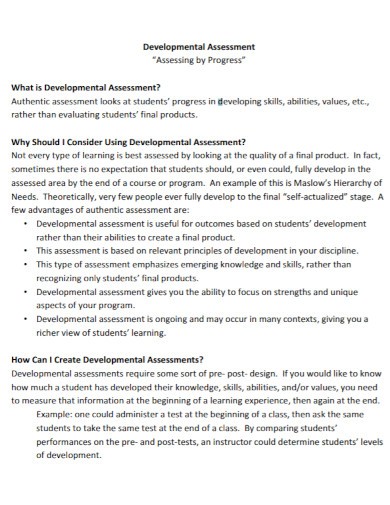
Size: 23 KB
2. Developmental Assessment of Children
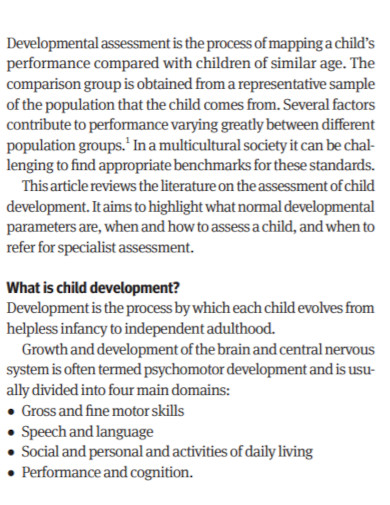
Size: 172 KB
3. Childhood Developmental Assessment
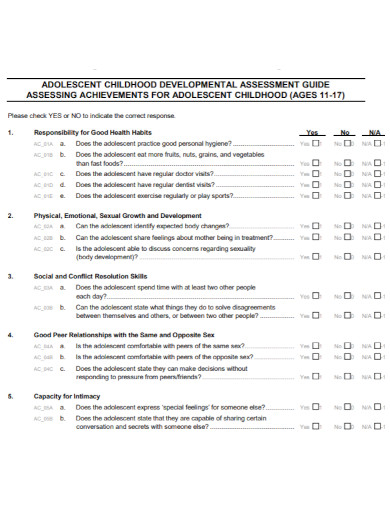
Size: 38 KB
4. Standard Developmental Assessment
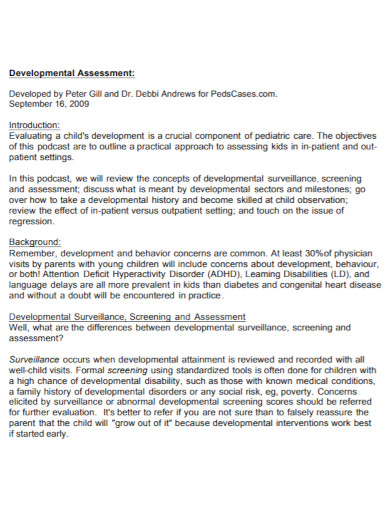
Size: 310 KB
5. Developmental Assessment System
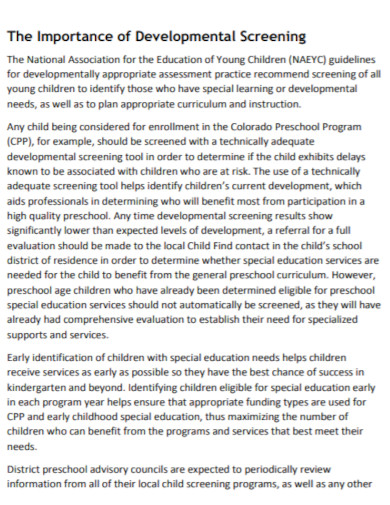
Size: 251 KB
6. Developmental Assessment of Play
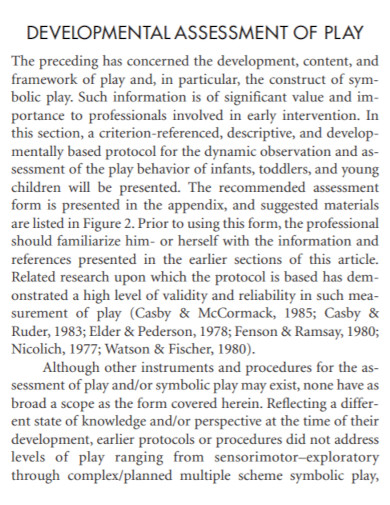
Size: 106 KB
7. Draft Developmental Assessment
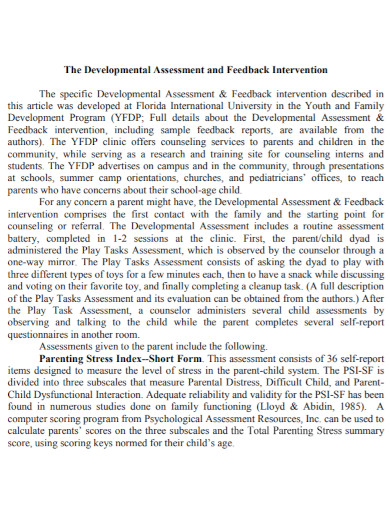
Size: 328 KB
8. Developmental Assessment in Community Colleges
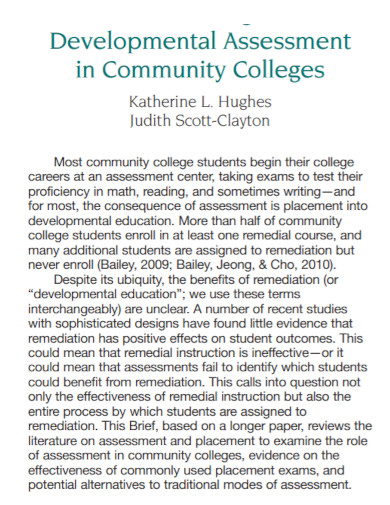
Size: 55 KB
9. Motor Developmental Assessment
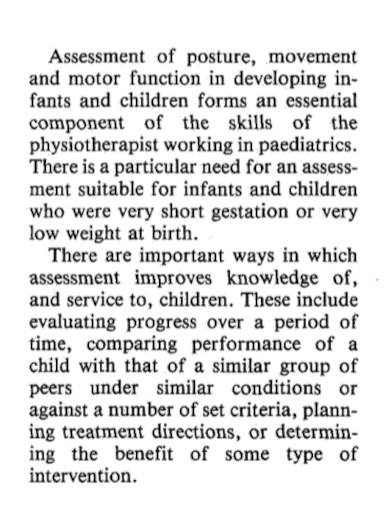
Size: 884 KB
10. University Developmental Assessment
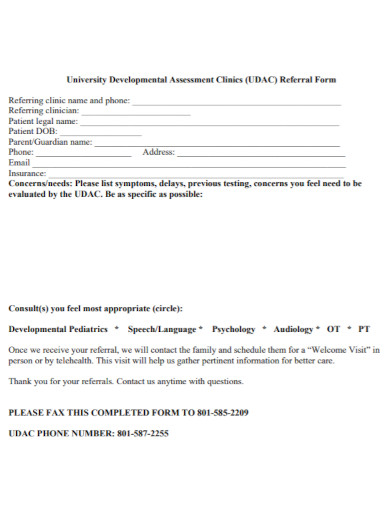
Size: 131 KB
11. Developmental Assessment in PDF

Size: 387 KB
Definition of Developmental
Developmental means relating to the process of change or growth. The act of connecting something with change or growth. The process of developing change, growth and progress in a positive way. It is connected to the sudden change of environment, physical, social and mental. In addition to that, it is also the process of reinforcing growth or change for a better and stronger form. Lastly, development is the key to a good livelihood for a thing or a person to come out as a better version of themselves.
Definition of Assessment
An assessment is the process of assessing, evaluating and giving your scientific judgement. A series of tests that you give out to a student or child to see their progress unfold. To understand the specific needs one must do a series of examinations to target the specific needs . To be able to do the assessment, one must understand the reason for using it. In addition to that, it is to assess or to test how far a student’s development has progressed. Through a series of questions, data and analytical research being done. Assessments are a helpful tool to know the development of a child’s progress in school.
Definition of Developmental Assessment
A developmental assessment is the act of mapping out a child or a student’s performance. By understanding what the child may need . A child’s needs may be different from that of the whole population, but it may also be the source of better development compared to their peers. Of course, comparing their performance and development with their own peers is necessary to understand the growth. The comparison is taken from the sample of the population the child or the student is from. Of course, there are some factors that could vary a child’s performance and development. But to be able to know what causes it and what can be done, you do the assessment. The developmental assessment helps track your child or student’s growth physically, mentally and psychologically. By making observations and gathering data, analyzing and evaluating the progress of the child through the assessment .
Purpose of Developmental Assessment
The purpose of doing a developmental assessment is to list down the needs of your student or your child. To find any progress in areas that include cognitive, social, emotional, psychological, and physical. It is also to be able to know the strengths and weaknesses of the child and aim on making it better for them. The assessment is of course tailored to the student or the child’s age and suspected developmental issue. If you believe your child or the student may have difficulties in areas like language and communication compared to their peers, the assessment is able to answer that issue for you. As well as looking for a way to solve or to eliminate the issue altogether.
Tools to Use for Developmental Assessment
- Questionnaire
Tips for Writing a Developmental Assessment
Here are some tips you can use when doing a developmental assessment. These tips are the road map to understanding and doing the assessment. However, how you do your assessment is always up to you. These are merely suggestions or something to guide you through.
- Understand the child’s needs
- Gather important information
- Analyze the data gathered and pinpoint the areas
- Evaluate the assessment and give your assessment
- Update ever so often for any changes in the development of your child
How can a developmental assessment help me understand the problem my child is experiencing?
A developmental assessment helps you understand and pinpoint what areas your child needs to improve on. This assessment shows you the things that they may need and the solutions that could help them as well. Doing the assessment not only helps you understand and see through your child’s development, but it also helps by listing down the strengths and weaknesses and things that can still be improved on. This is of course based on children their age, just to see any difference between them and your child.
Can the evaluation be used to diagnose my child?
People who often use this type of assessment are those who are in the medical field. Psychologists, student counsellors or even nurses. The evaluation cannot be used as a diagnosis unless there is a person in the medical field when the assessment has been done. The developmental assessment’s purpose is to pinpoint the problem, but not to make a diagnosis as to what your child may be lacking or suffering. The evaluation of the assessment is simply a way of saying this is what they believe your child may be lacking on. To get a better understanding, ask experts rather than relying on the tool alone.
Are there specific types of people who are able to use the assessment?
It is mostly people who study the development of a child. This may include counsellors, psychologists, psychiatrists and for some nurses. Especially if the child may have a physical issue rather than a mental or psychological issue.
Is there any truth to the evaluation?
The assessment evaluation only lists down the possible issues your child may be experiencing. This is based on the child’s age and environment . The truth to the evaluation may differ from child to child.
Any parent or teacher would want their child or student to excel in whatever they do. But there are times when we think that we failed them when they do not develop in a way that they should. Rather than having to think of what may be wrong physically or mentally, or simply give out guesses, a developmental assessment should be given. To be able to understand and find a better solution to the child’s problem.
AI Generator
Text prompt
- Instructive
- Professional
10 Examples of Public speaking
20 Examples of Gas lighting
Resume Worded | Career Strategy
14 learning and development specialist cover letters.
Approved by real hiring managers, these Learning and Development Specialist cover letters have been proven to get people hired in 2024. A hiring manager explains why.

Table of contents
- Learning and Development Specialist
- Senior Learning and Development Specialist
- Senior Learning and Development Manager
- Learning Experience Designer
- Corporate Training Specialist
- Corporate Trainer
- Alternative introductions for your cover letter
- Learning and Development Specialist resume examples
Learning and Development Specialist Cover Letter Example
Why this cover letter works in 2024, highlighting relevant experience.
This cover letter emphasizes the candidate's experience in developing customized learning solutions, directly addressing the skills required for the role. Be sure to showcase your relevant experience in a way that demonstrates your ability to meet the needs of the company.
Sharing Specific Achievements
By sharing a specific accomplishment, the candidate shows they have a track record of success in their field. Use quantifiable results to showcase your impact and show how your skills will benefit the company you're applying to.
Display Impact and Results
When you share the impressive results you've achieved, like reducing the learning curve by 30%, it gives me a glimpse of the value you can bring to our team. This isn't just some abstract promise of potential, it's solid proof of your capacities. Keep those metrics coming!
Highlight Your Communication Skills
The ability to distil complex information into something digestible is a vital skill in the learning and development sector. By pointing this out, you're showing you can bridge the gap between jargon-filled info and effective learning. That's a skill we could really use here.
Show tangible achievements
Clearly stating your successes, especially quantifying them, can be really impressive. It immediately signals to me you know what you're doing and you can get results. Plus, increasing new hire retention by 25% is very specific and shows that you're tuned into what matters to a company.
Highlight effective leadership
By mentioning that you developed a training program that led to a 40% increase in promotions, you're demonstrating effective leadership and the ability to make a significant impact. This tells me that you're not just a contributor, but a catalyst for growth.
Enthusiasm for company mission
Specifically expressing your excitement for Google's mission and the role you're applying for shows that you're not just hunting for any job. It's clear that you've done your homework and you're genuinely enthusiastic about contributing to the company's goals.
Aligned values
When you talk about a company's commitment to people development and how it resonates with you, it suggests that your values align with the company's. This is crucial for fit and it's something I'd be looking for as a recruiter.
Gratitude and forward-looking
Expressing gratitude for the consideration and showing enthusiasm for potential future contributions is a nice wrap-up. It leaves me with a positive feeling about your application and eagerness for our potential conversation.
Share your passion for learning
Talking about the moments that make you happy in your work shows you care deeply about your job. This is important for a learning and development specialist.
Detail your experience
When you list the specific skills you've improved and achievements, it makes it easy for me to see what you can do. This is good in a cover letter.
Promise similar success
By saying you will bring the same drive to a new role, it makes me believe you can achieve great things with us too.
Connect your background to the role
Using your own education to show you understand high-quality learning makes you a more convincing candidate.
Show appreciation and eagerness
Ending your letter by thanking the reader and expressing desire to talk more about the role is polite and shows you are eager.
Does writing cover letters feel pointless? Use our AI
Dear Job Seeker, Writing a great cover letter is tough and time-consuming. But every employer asks for one. And if you don't submit one, you'll look like you didn't put enough effort into your application. But here's the good news: our new AI tool can generate a winning cover letter for you in seconds, tailored to each job you apply for. No more staring at a blank page, wondering what to write. Imagine being able to apply to dozens of jobs in the time it used to take you to write one cover letter. With our tool, that's a reality. And more applications mean more chances of landing your dream job. Write me a cover letter It's helped thousands of people speed up their job search. The best part? It's free to try - your first cover letter is on us. Sincerely, The Resume Worded Team
Want to see how the cover letter generator works? See this 30 second video.
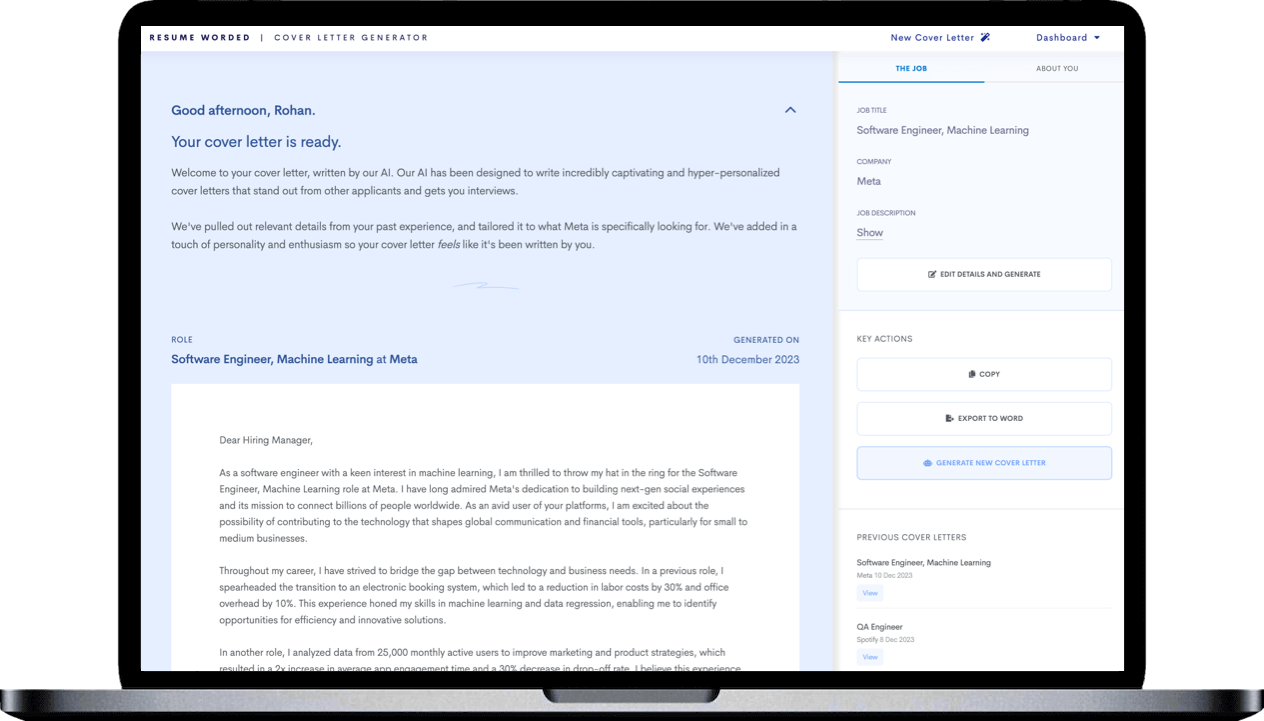
Start with excitement for the learning and development role
Beginning your cover letter with genuine excitement about the position at Udemy immediately captures attention. It sets a positive tone and shows your enthusiasm for the role and the company.
Detail your learning and development achievements
By discussing specific achievements in your career, you underline your capability to deliver successful learning and development initiatives. This direct evidence of your skills and impact makes your application stand out.
Use feedback to show your training effectiveness
Highlighting the positive feedback from your sessions is an excellent way to showcase your ability to engage and transform learners. It reveals that your methods are not just theoretically sound but also practically effective.
Emphasize storytelling in learning development
Stressing your skill in storytelling suggests you understand the importance of engaging content in learning. This ability to connect on a deeper level can make learning more effective and enjoyable.
Close with gratitude and a call to action
Thanking the reader and expressing a desire to further discuss your contribution shows you're not only polite but also proactive about the opportunity to make a difference at Udemy.
Show your learning and development impact
Talking about your excitement for the impact of learning and development shows you understand the role's core value. It helps me see your passion.
Detail your career achievements
By mentioning specific achievements, like improving time-to-productivity and satisfaction scores, you make your past work more real and impressive to me.
Highlight leadership curriculum revamping
Discussing your efforts in revamping leadership development curriculum demonstrates your initiative and ability to improve existing programs.
Express eagerness to contribute
Your excitement to bring skills to our team is infectious. It tells me you're ready and eager to make a positive difference.
Invite further discussion
Ending with an invitation for further discussion shows professionalism and openness to engage, making you a strong candidate in my eyes.
Senior Learning and Development Specialist Cover Letter Example
Emphasise leadership experience.
Leading a team that developed a company-wide e-learning course is a big deal. It shows you're a leader and that you can handle large-scale projects. You're not just talking about your leadership skills, you're backing them up with solid evidence. That's something that definitely catches my eye.
Reinforce Your Expertise
You're not just saying you're good at designing and implementing training programs, you're asserting it with confidence. That's a great move, because as a hiring manager, I need to know you believe in your abilities just as much as I should. It gives me confidence in your potential fit for this role.
Personal connection to the mission
Explaining how a company's mission has affected you personally makes your application feel more genuine.
Highlight your growth and achievements
Showing how you've developed over time and the positive outcomes you've achieved gives confidence in your abilities.
Show your diverse learning interests
Mentioning your own learning on the platform displays you're not just an employee but also a user who values their services.
Express your excitement to contribute
Stating your enthusiasm to use your background for the benefit of others underlines your commitment to the role.
Thank them and express desire to engage further
Gratitude and eagerness to discuss how you can contribute are key to leaving a positive impression.
Connect personal belief to company values
Starting with a personal belief that aligns with the company's values creates an immediate connection, showing you're a good fit culturally.
Quantify training program success
Mentioning specific results, like a 15% increase in revenue, gives me clear evidence of your ability to drive business outcomes through learning programs.
Customize development plans for leadership
Your work with executive coaches and 360-degree assessments highlights your strategic approach to tailored leadership development, showcasing your advanced skills.
Share your inspiration for innovative solutions
Communicating your inspiration to develop learning solutions that have a business impact makes you stand out as a visionary in the field.
Polite application consideration request
Asking politely for your application to be considered while expressing a desire to discuss your contributions further shows humility and confidence.
Senior Learning and Development Manager Cover Letter Example
Highlighting successful projects.
When you talk about leading a project that boosted employee engagement by 30%, it tells me you're capable of leading major initiatives and delivering results. Seeing such concrete outcomes gives me confidence in your abilities.
Showcasing innovative initiatives
Partnering with universities for a continuous learning program is innovative and shows that you're not afraid to think outside the box. Not to mention, a 50% increase in skills enhancement is a substantial win that definitely grabs my attention.
Expressing alignment with company culture
By talking about how joining Amazon aligns with your desire for continuous improvement and innovation, you're showing your awareness of the company's culture and indicating that you'd be a great fit.
Highlighting company's mission
When you speak about Amazon's commitment to nurturing talent and your eagerness to contribute to it, it's clear that you understand and value the company's mission. This tells me you're more likely to be invested in your work and the company's success.
Expressing thanks and eagerness
Thanking the reader for their time and expressing an eagerness to discuss how you can contribute to Amazon's goals is a respectful and positive note to end on. It shows that you're serious about this opportunity and ready to take the next step.
Highlight a moment of realization
Share a specific moment that made you want this job. It helps me see what drives you and that you have a clear reason for applying.
Quantify your achievements
When you talk about your successes with numbers, it's easier for me to see the real impact you could bring to our team.
Emphasize shared values
Talk about how your personal beliefs align with the company's mission. This helps me understand why you'd fit in well with our culture.
Focus on your unique approach
Explain what makes your way of managing learning and development different. It gives me a glimpse into how you work and think.
Offer to discuss further
Inviting a conversation shows you're truly interested and see this as more than just a job application. It's a chance to make a real connection.
Learning Experience Designer Cover Letter Example
Connect personally in your learning experience designer cover letter.
Sharing a personal story right at the start makes your cover letter memorable. It shows you're not just looking for any job, but this specific role at Skillshare excites you because of your genuine passion for learning and creativity.
Show your learning design impact with real results
Mentioning a specific project where your work led to measurable improvements demonstrates your ability to create effective learning experiences. It's one thing to say you're good at your job, it's another to prove it with numbers and positive feedback.
Highlight your engagement with the company's community
When you mention being a part of the company's community, it shows you already understand and appreciate their culture. This makes you more than just an applicant; you're a fan and future advocate for their mission.
Leverage your skills for the community's benefit
Stating how you want to use your skills to empower others not only highlights your expertise but also your motivation to contribute positively to the community. It's clear you're not just seeking a job, but a way to make a meaningful impact.
Express gratitude and eagerness in your conclusion
A polite thank you and expression of enthusiasm about the potential opportunity rounds off your cover letter on a positive note, leaving a lasting impression of your professionalism and passion.
Corporate Training Specialist Cover Letter Example
Connect with personal story.
Talk about your past experiences with a personal touch. This makes your letter memorable and shows I'm reading about a real person, not just a list of achievements.
Show your training impact
Describe how your work improved the company and helped people. This tells me you care about results and the difference you can make.
Align with company mission
Mention why the company's goals matter to you. It shows you've done your homework and you're not just looking for any job but this job.
End your letter by saying you want to talk more about how you can help. It makes you seem ready and excited for the next step.
Close with professionalism
Ending with a polite sign-off is always a good idea. It keeps things professional and shows you respect the reader's time.
Corporate Trainer Cover Letter Example
Show your teaching skills.
Talking about your ability to simplify complex topics shows you're a skilled educator, perfect for a corporate trainer role.
Highlight program success
Describing your experience in designing and delivering various training programs proves your versatility and success as a corporate trainer.
Blend training methods
Using a mix of teaching methods demonstrates your innovative approach to corporate training, ensuring you meet different learning styles.
Express your enthusiasm
Sharing your excitement about joining the team adds a personal touch, making your application memorable for a corporate trainer role.
Close with gratitude
Ending your cover letter with a thank you note leaves a positive impression and shows good manners, essential for any job, especially a corporate trainer.
Alternative Introductions
If you're struggling to start your cover letter, here are 6 different variations that have worked for others, along with why they worked. Use them as inspiration for your introductory paragraph.
Cover Letters For Jobs Similar To Learning and Development Specialist Roles
- Group Learning and Development Specialist Cover Letter Guide
- Learning and Development Executive Cover Letter Guide
- Learning and Development Manager Cover Letter Guide
- Learning and Development Specialist Cover Letter Guide
Other Other Cover Letters
- Business Owner Cover Letter Guide
- Consultant Cover Letter Guide
- Correctional Officer Cover Letter Guide
- Demand Planning Manager Cover Letter Guide
- Executive Assistant Cover Letter Guide
- Operations Manager Cover Letter Guide
- Orientation Leader Cover Letter Guide
- Plant Manager Cover Letter Guide
- Production Planner Cover Letter Guide
- Recruiter Cover Letter Guide
- Recruiting Coordinator Cover Letter Guide
- Site Manager Cover Letter Guide
- Supply Chain Planner Cover Letter Guide
- Teacher Cover Letter Guide
- Vice President of Operations Cover Letter Guide

Thank you for the checklist! I realized I was making so many mistakes on my resume that I've now fixed. I'm much more confident in my resume now.

- Sample Letters
FREE 9+ Sample Assignment Letter Templates in PDF | MS Word
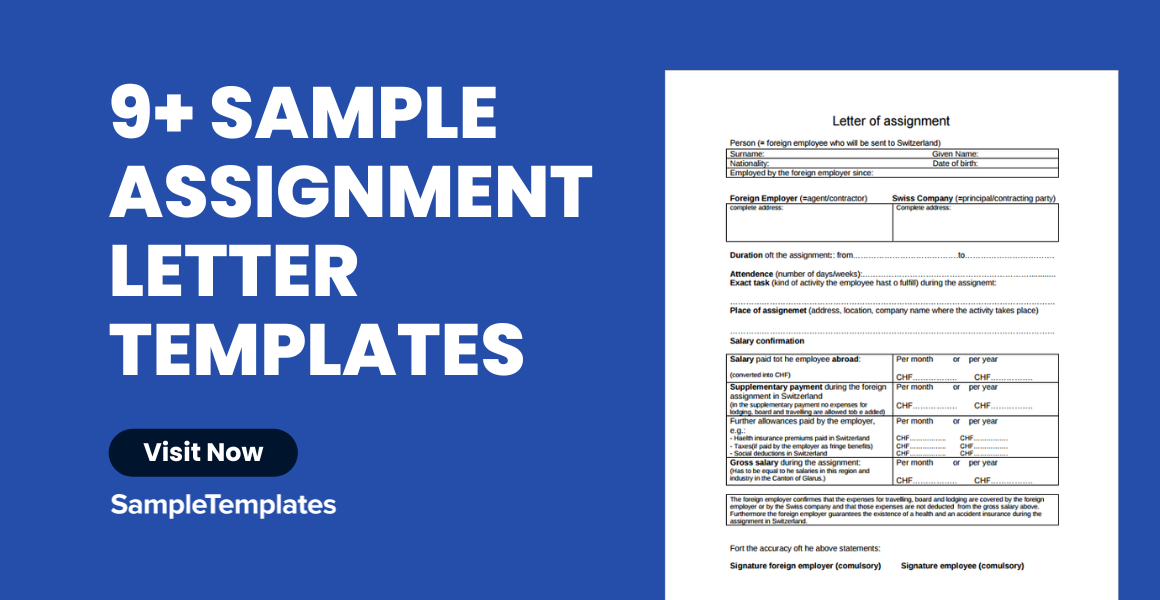
An assignment letter is a document that is used mostly in situations such as business bankruptcy and insolvency. It is a legal document which can be presented in courts when handling different cases. Examples of scenarios whereby this paper comes in are when a business owner is assigning a portion of his or her assets to a trustee for selling purposes and also when assigning specific rights to another person such as collecting payment on your behalf.
Assignment Letter
Sample personal business letter - 9+ documents in pdf, word, sample thank you letter to boss - 22+ free documents download ..., sample trademark assignment form - 7+ examples in pdf.
Our assignment templates get designed in the best way possible to usher you properly when creating one. An assignment letter template may also be said to be a Professional Letter of assignment or an assignment letter sample.
Salary Assignment Letter

Size: 130 KB
The top of the page should have the name of the person or the entity issuing the letter together with their personal information such as the telephone number, email address, and the postal address. Below that it should indicate that it is a letter of assignment to give the form an identity. Next should be the full names of the people or entity in the agreement alongside their personal information.
After that, mention the duration of the assignment and the location of where the deal takes place. The body of the document should be concluded by listing all the details of the money that they parties will be handling. Finally, the parties involved should sign the paper to seal the agreement.
Appraisal Assignment Letter
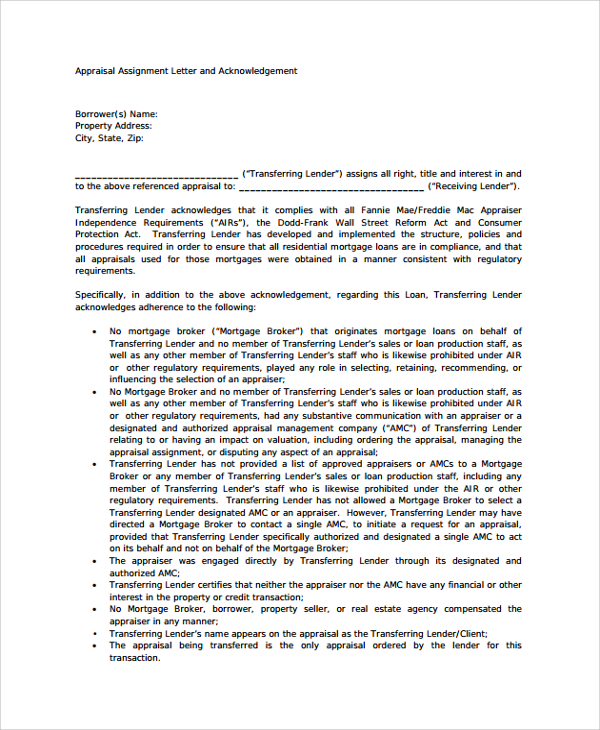
Size: 38 KB
The top of the form should read that the document is an appraisal assignment letter for easier identification. The name plus the postal address of the person or company issuing the appraisals should be listed next. After that, a declaration statement mentioning the names of the parties involved in the agreement should be put down saying who has assigned rights to the other.
The agreement should always comply with the standards set by law. Other acknowledgments that each party is supposed to heed to should also get listed in this document. The model should conclude by stating the period when the agreement will be active.
Voided Assignment Letter
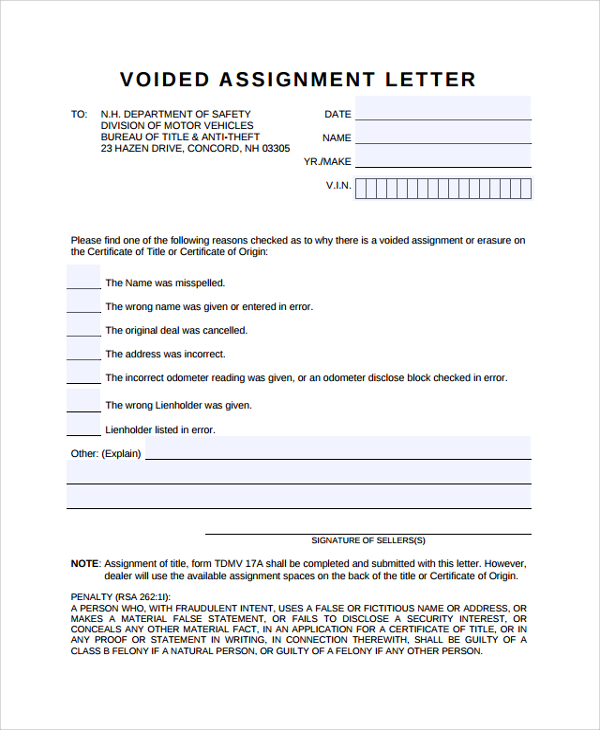
Size: 37 KB
The top of the model should read that it is a voided assignment letter for quick identification of the form. After that, on the left, the name of the person of corporate who is going to receive the document is listed together with other personal information such as a postal address and an email address.
The right should have the date of when the paper gets published. Finally, the reasons as to why there is a voided assignment letter must be on it and signatures of the parties involved should also be given to show that they agree with the stated reasons.
Incentive Assignment Letter
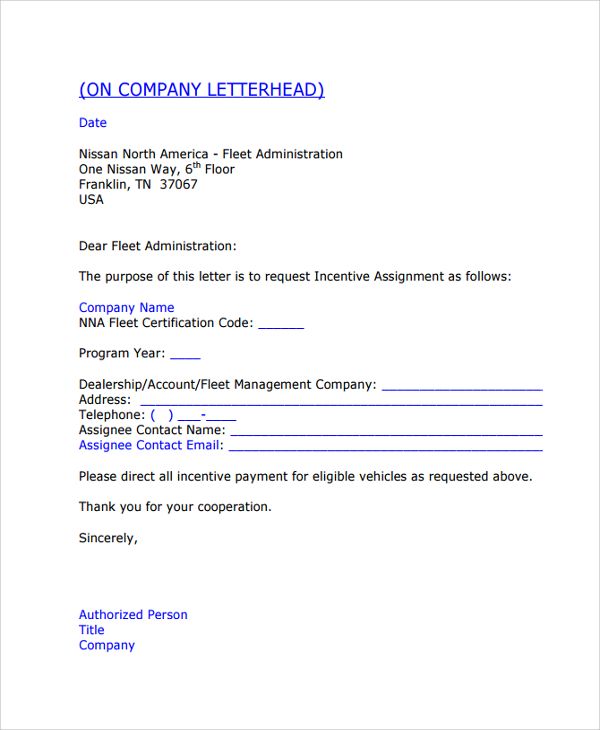
Size: 42 KB
The name of the company issuing the letter should be the first thing on the document and the date below that. Next should be the name and personal details of the person or entity meant to receive it. The incentive assignment should be listed giving all crucial information about it and contacts which the receiver can contact for further negotiations. Finally, it concludes with a short formal message to the receiver.
Professional Assignment Letter
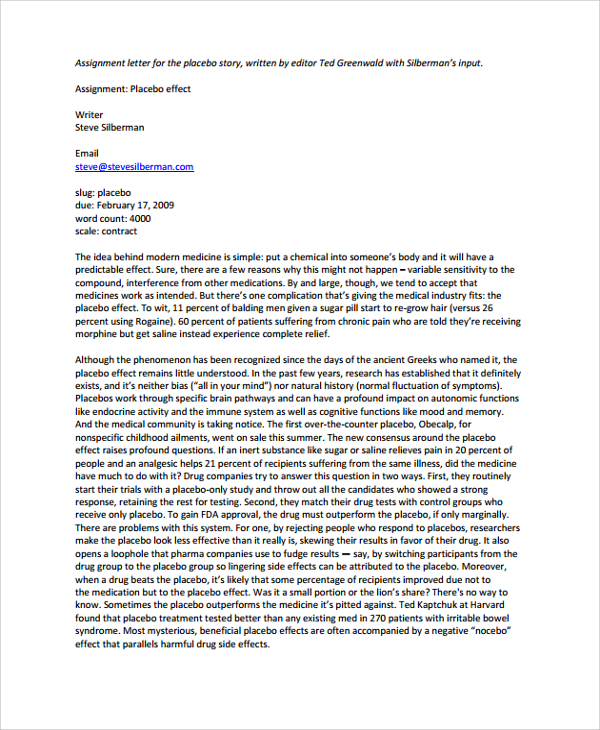
Size: 355 KB
Buddy Assignment Letter
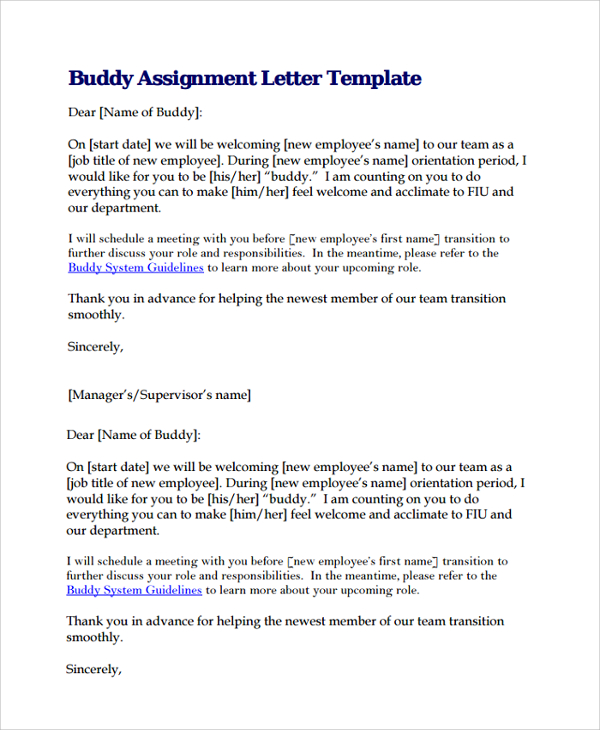
Size: 155 KB
Friendly Assignment Letter
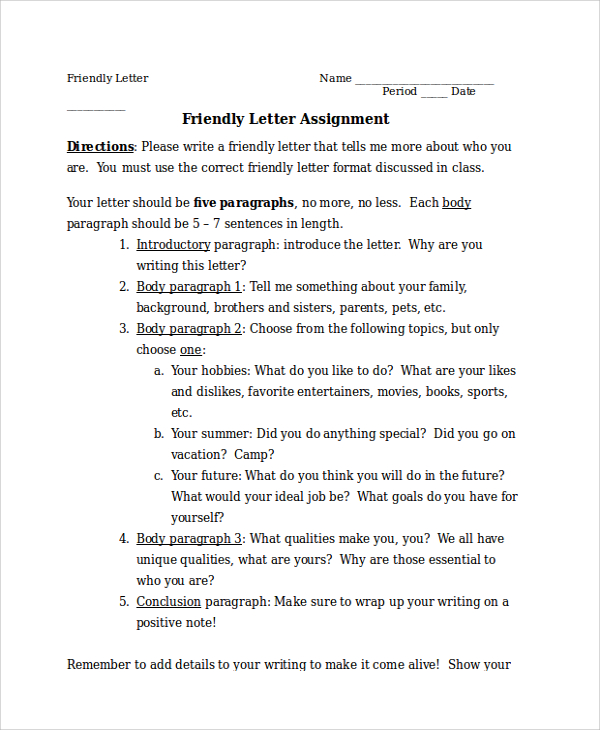
Size: 31 KB
Sample Assignment Letter
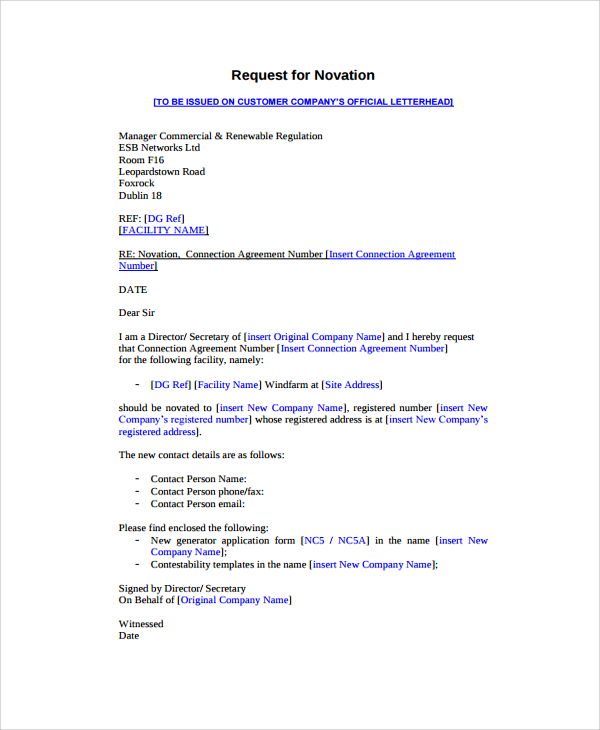
Size: 137 KB
Assignment Letter from Trainee
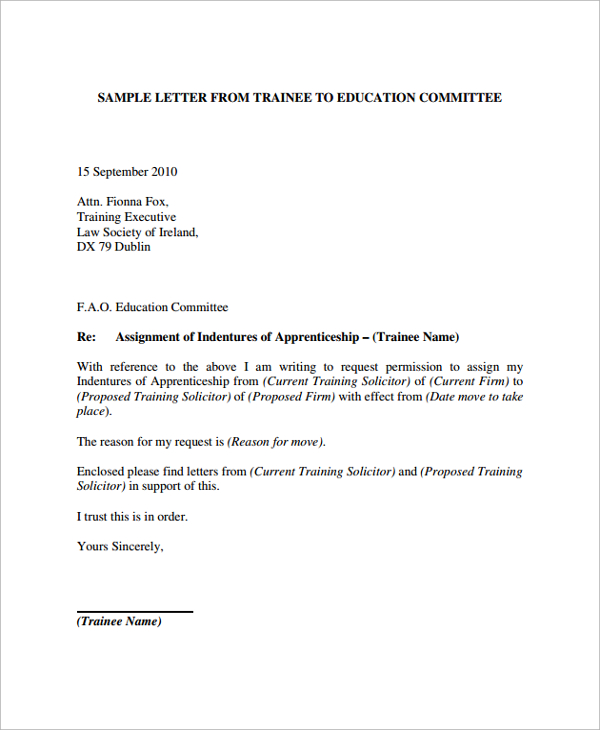
Volunteer Assignment Letter
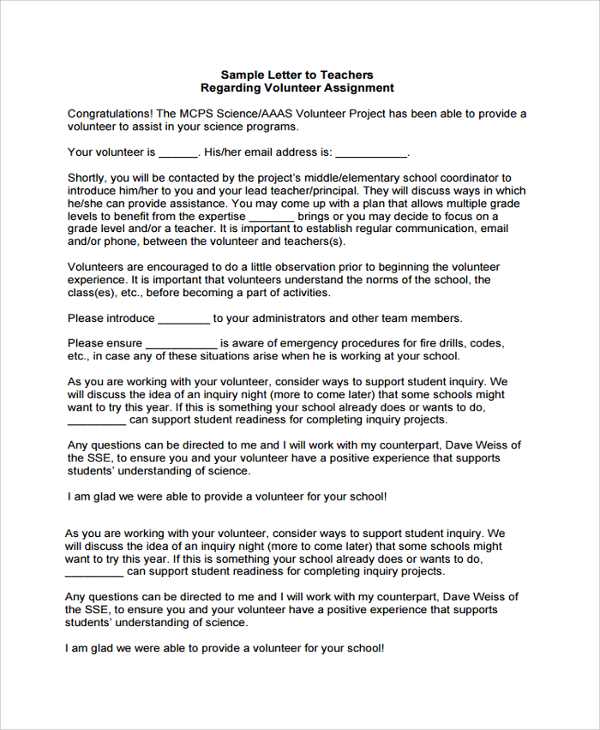
Size: 52 KB
What are the Advantages of Having our Assignment Letter Templates?
One may lack sufficient knowledge on what to include when forming this document; therefore, the main benefit of having our template is that it gives you the proper guidance on which information to include in your paper and an order of how to put it down.
Another advantage is that our templates are files which you can save on you PC; thus, you can make references from the file again in future when forming assignment letters. Finally, our templates are always designed to help you create one as per the standard legal requirements. You may also see Sample Personal Letters
How Have We Made our Assignment Letter Templates the Best for you?
Our models get worked on by the experts whom we have interviewed thoroughly and proven that they are talented. We also ensure that they have sufficient experience in the field for our templates to be as effective for you as possible. Another way we have made our templates the best for you is by making them editable such that you can do any modifications you prefer on them. Finally, they are printable for you to be able to make as many copies as you want. You may also see Friendly Letters
Which are the Most Crucial Aspects that I Should Entail in my Assignment Letter?
Always list the name of parties in the agreement and also sufficient personal information about them. Never forget to indicate the date you publish the model and the period of how long the contract will be valid. Ensure that both parties agree on what gets stated on the Professional Letters then seal the deal with signatures of each. Finally, since it is a legal document, always ensure that your agreement complies with the provisions of the law to avoid awful penalties.
We ensure that we meet the requirements of all our customers according to their needs. Those that would want a fully customed model can always communicate to us so that we can direct you to our experts to help them understand what kind of make you want. We have customer care agents that are always available to tend to all the inquiries you may have and the consultations you may need. Consider acquiring our accessible and affordable assignment letter template today, to guide you while creating the document you need.
If you have any DMCA issues on this post, please contact us !
Related Posts
Sample visa invitation letter templates, how to write an application letter for employment [ with samples ], sample community service letter templates, sample commitment letter templates, sample application letter templates, letterhead samples, sample visa sponsorship letter templates, application letter templates, sample job application cover letter templates, formal excuse letter templates, leave letter templates, sick leave letter templates, free 10+ sample inform letter templates in pdf, free 13+ sample closing business letter templates in pdf | ms word | google docs | pages, 10 free notice to quit letter samples & templates, sample assignment of contract - 6+ free documents download in ..., sample assignment of mortgage template - 9+ free documents ..., sample assignment agreement template - 9+ free documents ..., sample appointment letter - 28+ download free documents in pdf ....

IMAGES
VIDEO
COMMENTS
A developmental job assignment is a formal opportunity for an employee to develop professional knowledge, skills, and abilities that would not otherwise be available through their normal work activities. Developmental job assignments should be primarily a product of the employee's Performance and Development Plan (PDP).
PURPOSE. During the 12-month program, each LEAP candidate is required to complete significantly challenging developmental assignments totaling four months of full-time service.*. The purpose of a developmental assignment is to provide you with the opportunity to broaden your managerial and leadership experiences while learning more about the ...
Developmental Assignment Template. Developing leaders by placing them on specific assignments is a great way to broaden their perspective while ensuring their highest development needs are being addressed in a structured way. The template (download link below) ensures transparency regarding developmental focus and management expectations of the ...
According to Walters, both the employee and the organization benefit from the developmental assignment program. Employees gain new skills and experiences and organizations benefit because ...
Work Assignment Practices. The employee's supervisor: Identifies and assigns specific work projects which relate to IDP development objectives and activities; Discusses with the employee how the project's content or process ties in with the IDP; Communicates any specific standards or expectations for project results and developmental ...
Employee development focuses on collaborating with employees to enable them to acquire, develop, improve, and hone existing skills. It aims to build a talent pool to bolster the company's mission while creating highly engaged employees. Skills themselves refer to the mix of abilities, experiences, and qualities one may use to get stuff done.
Our data are now based on a more demographically diverse sample from across types of organizations and management levels. This led to a broader framework that describes ten types of developmental challenges—characteristics or features of assignments that stimulate learning (e.g., influencing without authority, fixing inherited problems, and ...
The supervisor will be required to provide the following information to the BC-HR Manager at the time a request to appoint an employee into a developmental opportunity work assignment is submitted: How and where the opportunity was announced/advertised to potential applicants; A copy of the developmental opportunity announcement (see sample below);
Developmental Assessments Example (sample) The Developmental Assessments PDF is a comprehensive tool enabling professionals to deeply understand a child's development. It covers essential aspects such as the child's background, strengths, and areas for growth, offering a holistic view of their current situation and potential.
Project 1: Developmental Letters. Professor Archer. PSY 100: Project #1: Developmental Letters. Letter 1: To My Future Child: Hey Love, We've been talking about it for so long now, but the day has finally arrived. The time has come for you to become an "adult", and soon you will be heading to college.
Following are the seven steps for designing a stretch assignment: 1. Analyze employee experiences. Before creating your stretch assignment, evaluate the candidate in comparison to your succession plan. Determine what skills, knowledge or experiences an employee could develop prior to taking on an advanced role at the company.
Instructions for this assignment. The interview is one of the research methods used by developmental psychologists. For this assignment, you will interview 4 individuals, ask each of them the same set of questions, then report and discuss your observations. Interview one individual from each of these 4 categories according to this schedule:
View Developmental Letter Assignment.docx from PSYC 231 at St. Ambrose University. Developmental Letter Assignment Jake Schmeichel 04-04-2022 Professor Feigel Liberty University PSYC 231 Hello son ... Module 7 Independent and Dependent samples t-test.docx. the smallest dividend payout To that end they argue that the firm should take on ...
1) Letter of Interest (not to exceed one page): The letter of interest should clearly articulate the applicant's career goals and how this developmental assignment will support the applicant in gaining critical competencies to serve the Army as an environmental professional. The letter will
The APG wide Employee Developmental Assignment Program will provide opportunities for employees to learn and gain experience in different organizations as together, we modernize the Army of 2030 and 2040. 179-Day Developmental Assignment Opportunity at ATEC HQ G-3/5/7, Senior Test Operations Officer, NH-03/04 (GS 12-15); Leadership Endorsement ...
The authors meant to ensure that the sample would comprise experienced medical experts who had post-graduate residents under their supervision. ... 2019 and August, 2019. An invitation letter to participate in the study comprising a brief introduction of the researcher and the purpose of the study was emailed to the participants a few days ...
Developmental Letter Dear son, Since I am going to be away for the next few years, I wanted to write you a letter to help you understand the changes that your body will come across. Maybe it will help explain certain things that you will see and feel. "Hear, my son, your father's instruction, and forsake not your mother's teaching." (Proverbs 1:8, ESV) First of all, the changes that ...
Sample 1. Developmental Assignments. An employee performing duties out of class for training or developmental purposes shall be informed in writing of the purpose and length of the assignment during which there shall be no extra pay for the assignment for the first six (6) months. For assignments that exceed six.
Open a computer word processor program, and on the first three lines place the name of the person the letter is addressed to, followed by the company and the date. Begin the letter with a salutation such as "Dear Mr. So-and-So" or "To Whom It May Concern.". Write the first paragraph to explain the position you were originally assigned.
Developmental means relating to the process of change or growth. The act of connecting something with change or growth. The process of developing change, growth and progress in a positive way. It is connected to the sudden change of environment, physical, social and mental. In addition to that, it is also the process of reinforcing growth or ...
As a lifelong enthusiast of learning and development, I was thrilled to discover the Learning and Development Specialist role at Amazon. My personal experiences with Amazon's innovative approach to customer service and user experience have always left me impressed, and I am excited to contribute my expertise in training and development to a ...
201-555-0154. [email protected] May 10, 2023 Sandler & Sons Dear Saul Sandler, I am excited to apply for the development associate position at Sandler & Sons because I believe my experience in fundraising and target acquisition can be an asset to your development team. With over three years of experience in account management and lead ...
gl.ch. Details. File Format. PDF. Size: 130 KB. Download. The top of the page should have the name of the person or the entity issuing the letter together with their personal information such as the telephone number, email address, and the postal address. Below that it should indicate that it is a letter of assignment to give the form an identity.